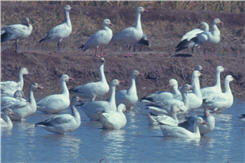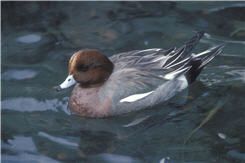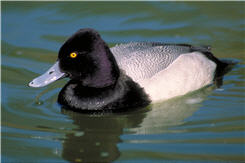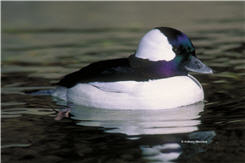 Fulvous
Whistling Duck
Dendrocygna fulva
Fulvous
Whistling Duck
Dendrocygna fulva
A
population collapse that eliminated the Fulvous Whistling Duck from
Breeding
distribution:
The status of the Fulvous Whistling Duck in
Migration: Stephens (1919a) wrote
of the Fulvous Whistling Duck, “Rather common spring migrant. Rare winter
visitant. Stragglers may remain through summer and breed.” Yet two
of the three SDNHM specimens were collected in fall: Mission Bay (Q8),
In the 1970s and 1980s free-flying Fulvous Whistling Ducks kept at Sea World
and the
Winter: One specimen was collected 5 miles west of Santee (P11) 14 December 1954 (SDNHM 30023), another at San Diego in December, year not cited (Salvadori 1895).
Conservation: The reasons for the
Fulvous Whistling Duck’s extirpation remain unclear. The species is not
dependent on natural habitats; in the southeastern
Greater White-fronted Goose Anser albifrons
Like
southern
Winter: The Greater
White-fronted Goose is noted in
Migration: Even within
Conservation: The White-fronted
Goose’s first population crash probably took place largely by the end of the 19th
century; Stephens (1919a) wrote that the species was only “formerly
common.” Through the second half of the 20th century numbers
seen in
Taxonomy: A definitive treatment
of the subspecies of the Greater White-fronted Goose in
The
Snow Goose is a rare winter visitor to
Winter: The Snow Goose’s
distribution in
The Snow Goose does not use any site consistently. Though
Migration:
The Snow
Goose occurs in
The only records of stragglers are of one at Jacumba
26 April–5 June 1964 (G. McCaskie) and one in the
east
Conservation: In the 19th
century the Snow Goose wintered in coastal southern
Taxonomy: The subspecies of the Snow
Goose reaching
With
the steep increase of Ross’ Goose’s population through the second half of the
20th century, this species has become an annual winter visitor to
Winter: The distribution of
Ross' Goose in
Whereas Snow Geese often show up in
Migration: Like the Snow Goose, Ross’ Goose arrives in November. The earliest date is 8 November (1991, one found dead on the beach at Scripps Institution of Oceanography, O7, SDNHM 48060). Spring departure, however, is sometimes later than that of the Snow Goose. Migrants have been recorded as late as 28 March–2 April (2001, one at the Tijuana River mouth, V10, R. T. Patton) and 5–7 April (1985, one at Lake Henshaw, R. Higson, AB 39:349, 1985). The largest number of Ross’ Geese found in San Diego County, 22 at Bonsall (E8) 25 February 2000 (P. A. Ginsburg), were clearly migrants, as only a single individual had been at this site earlier in the winter.
One Ross' Goose at Buena Vista Lagoon (H6) failed to migrate north in the
spring of 1998 and remained there, with the domestic Mallards, until its death on
Conservation: In the 19th
century Ross' Goose likely occurred in
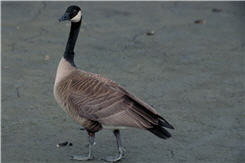 Canada
Goose
Branta canadensis
Canada
Goose
Branta canadensis
Roughly
5000 to 8000 Canada Geese spend the winter in
Winter: By the late 1990s,
At Lake Henshaw (G17) and nearby in the Warner Valley
numbers in the low hundreds are regular; during the atlas period our maximum on
the lake was 510 on 12 December 2000 (J. R. Barth).
Numbers on Lake Henshaw Christmas bird counts have
varied much more than at the goose’s other regular sites, from a high of 2581
on
The geese probably move freely among all the main wintering sites. Flocks are sometimes seen in flight far from them, such as 100 over El Monte Park (O15) 9 February 1998 (D. C. Seals) and 17 over Presidio Park (R8) 10 December 1997 (P. Unitt).
Migration: Mid November to late
February is the Canada Goose’s main season in
Breeding
distribution:
The Canada Goose had not been reported nesting in
Conservation: Like other geese, the Canada was abundant in the 19th century, then decimated by overhunting. With hunting regulated the numbers stabilized but, in San Diego County, loss of habitat remains a threat. A change is most evident in the San Luis Rey River valley of Oceanside, where Whelan Lake (G6) was formerly one of the goose’s main sites in San Diego County (Unitt 1984). From 1976 to 1980 the Oceanside Christmas bird count averaged 2809 Canada Geese; from 1997 to 2002 it averaged only 107. Even if many of these birds simply relocated to other wintering grounds within the county, the change was a response to rapid urbanization. Nevertheless, Christmas bird counts suggest the total number in the county remained fairly steady from at least 1985 through 2002.
In other parts of the United States the goose has adapted to suburbs and golf courses, domesticating itself. The establishment of nonmigratory geese in such places elicits human complaints about the birds’ copious droppings, fear over the spread of disease, and the growth of an industry in goose repellent. San Diego County could save itself from this conflict by curbing the proliferation of golf courses, where geese can graze year round, and leaving floodplains in their natural state, attractive to geese only during the winter rainy season. Release of captive geese should be forbidden, as these may form a nucleus around which wild birds settle. Better to preserve the goose’s natural migration, which inspires awe, than to encourage self domestication, which inspires contempt.
Taxonomy: Of the many subspecies of the Canada Goose, the primary winter visitor in San Diego County is the large B. c. moffitti Aldrich, 1946, which originates largely in the intermountain region and to which this account as a whole applies. Four San Diego County specimens have been preserved from Point Loma, Lake Henshaw, and Warner Ranch. One specimen from Lake Henshaw (SDNHM 42132) had been banded as a chick at Willard, northern Utah.
Canada Geese of intermediate size, B. c. parvipes (Cassin, 1852) or the possibly synonymous B. c. taverneri Delacour, 1951, may occur rarely, as they do around the Salton Sea (Patten et al. 2003). Under the name hutchinsi, A. W. Anthony (in Belding 1892) reported the Lesser Canada Goose to be numerous in parts of San Diego County, but there are no specific records. Guy McCaskie suspected a small Canada Goose among 20 large ones near Old Mission Dam (P11) 19 March 1977 to be a Lesser.
The smallest subspecies, the Cackling Goose, B. c. minima Ridgway, 1885, is a rare winter visitor, usually keeping to
itself rather than flocking with moffitti.
Records since those listed by Unitt (1984) include one at Famosa
Slough (R8) 25 October 1985 (D. Patla), one at Ocean
Beach (R7) 2 November 1995 (SDNHM 49432), and one in Mission Bay (Q8) 6
December 2000 (L. Johnson). Also, two Cackling Geese visiting spots with
domestic geese failed to migrate: one in the east basin of Buena Vista Lagoon
(H6) 11 February 1998–21 July 2001 (P. A. Ginsburg) and one at Lindo Lake (P14) 26 May 2000 (C. G. Edwards). The
primary winter range of the Cackling Goose is shifting north from the Central
Valley of California to the Willamette and Columbia River valleys of Oregon and
Washington (Mowbray et al. 2002), so the frequency of
this subspecies in San Diego County may decrease.
Finally, the Aleutian Canada Goose, B. c. leucopareia (Brandt, 1836), has been reported twice, on the basis of sightings of a flock of 13 in the Tijuana River valley 13–14 November 1981 (G. McCaskie, AB 36:217, 1982) and up to seven in San Dieguito Valley 16 December 1990–21 January 1991 (L. R. Santaella, AB 45:320, 1991). This formerly endangered subspecies, which winters largely in the Central Valley, has been restored, so it may become more frequent, unless its range shifts north like that of the Cackling.
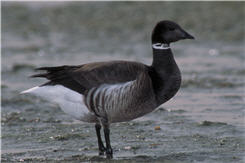 Brant Branta
bernicla
Brant Branta
bernicla
San Diego and Mission bays were once two of the Brant’s major wintering sites on the Pacific coast of North America. With uncontrolled shooting, then development of most of the bays, the Brant’s numbers collapsed. Since the 1970s they have increased again, so that by the end of the 20th century about 750 to 1500 Brant were wintering annually around San Diego. Eelgrass in the bays is the key food source sustaining the birds. In the mid 20th century many of the Brant shifted to new winter quarters in the Gulf of California, establishing a new migration route over the mountain passes of eastern San Diego County.
Winter: South San Diego Bay is currently the Brant’s primary habitat in the county. Within the bay the birds are concentrated strongly along the Chula Vista bayfront and in Emory Cove (U10), sites of the largest stands of intertidal eelgrass (Macdonald et al. 1990, Manning 1995). Covering virtually all of the Brant’s habitat in San Diego Bay weekly from April 1993 to April 1994, Manning (1995) found a December–January average of about 350 and a maximum of about 550. From 1997 to 2002 numbers were somewhat higher: Barbara C. Moore estimated 500 along the Chula Vista bayfront repeatedly through the atlas period. Totals on San Diego Christmas bird counts reached 1118 on 15 December 2001 and 1292 on 14 December 2002. Relatively few Brant use central and northern San Diego Bay; our highest count there was of 53 around North Island Naval Air Station (S8) 15 December 2001 (R. T. Patton).
Brant have used the San Diego River flood-control channel (R7/R8) for decades. Counts of 50 to 200 are regular here, with a maximum of 260 on 20 December 2000 (G. Grantham). Counts of 100 to 200 are now regular on Mission Bay, with a maximum of 230 on 7 December 1998 (J. C. Worley). Elsewhere along San Diego County’s coast, however, wintering Brant are rare. Our only December–January records during the atlas period were of one at Batiquitos Lagoon (J6/J7) 10 and 30 December 1998 (M. Baumgartel, R. T. Patton) and two at Los Peñasquitos Lagoon (N7) 3–4 January 1998 (K. Estey, D. K. Adams). The Oceanside and Rancho Santa Fe Christmas bird counts record the Brant rarely, just one or two individuals except for 50 on the Oceanside count 31 December 1977.
Migration: Fall migrants may arrive as early as 28 October (1972, one at the San Diego River mouth, G. McCaskie), but the third week of November appears to be the typical arrival schedule. The earliest date Preston and Mock (1995) recorded on central San Diego Bay was 22 November 1994 (43 birds). Southbound migrants usually pass through unnoticed, offshore or at high altitudes, but northbound migrants are conspicuous and often outnumber wintering birds—most Black Brant winter in Baja California. On San Diego Bay Manning (1995) recorded higher numbers in February and March than in December and January, up to 714 on 29 March 1994. Some birds are moving north as early as 2 February (1992; 75 flying past Los Coronados Islands, P. Unitt). By April most have departed, but a few are seen through early May. A few stragglers fail to migrate. Numbers of such oversummering birds range up to six near the Chula Vista Nature Center 30 May–5 June 1999 (B. C. Moore) and 10 in the Tijuana River estuary (V10) 27 June 1998 (C. G. Edwards).
The principal spring migration route for Brant leaving the Gulf of California crosses eastern San Diego County. The heart of the corridor parallels Highway S2 from the Anza–Borrego Desert up through San Felipe Valley to Lake Henshaw (G17). Most of the birds make the trip nonstop, noted only when they pause on Lake Henshaw because of storms or the fierce headwind so frequent at this season. Counts on the lake range up to 754 on 4 March 1983 and 688 on 16 March 1984 (R. Higson, AB 37:912, 1983; 38:958, 1984). Occasionally, however, Brant can be seen in flight headed northwest up the corridor, such as 15 near Canebrake (N27) 17 April 1998 (P. D. Jorgensen) and 40 in San Felipe Valley (H21) 26 April 2001 (P. Unitt). Spring migrants have been recorded widely elsewhere in eastern San Diego County, with up to 38 at Lake Cuyamaca (M20) 22 April 1967 (AFN 21:540, 1967), 50 flying up Banner Canyon (K21) 13 March 1977 (AB 31:1047, 1977), 75 at Yaqui Well (I24) 19 April 1984 (B. Wagner, AB 38:958, 1984), and 31 on the golf-course pond at Club Circle, Borrego Springs (G24), 19 April 1999 (P. D. Ache). Several have been found exhausted or dead, such as one near Canebrake 11 March 1989 (R. Thériault, SDNHM 47503).
The passage overland takes place mainly in March and April. In 1983, when El Niño generated repeated storms, Roger Higson monitored Lake Henshaw regularly and noted the Brant from 4 March to 29 April. Extreme dates are 18 January (1993, one on the Borrego sewage pond, H25, J. Dougherty) and 1 May (1992, one dead and one exhausted along Highway S2, R. Thériault), except for five at the Roadrunner Club (F24) 24 May 1988 (T. Hatch) and one at the Borrego sewage pond 1 June 1988 (A. G. Morley). Such records parallel the regular summer stragglers at the Salton Sea (Patten et al. 2003). It seems likely that southbound migrants follow the same route but are not detected because of the lack of headwinds impeding them.
Conservation: Nineteenth-century writers commented on the fabulous abundance of the Brant on San Diego Bay, but the only specific estimate is of 50,000–100,000 at Spanish Bight (now filled) between Coronado and North Island in the 1880s (McGrew 1922). By the 1890s these numbers were already being depleted (Belding 1892), and by the early 20th century the Brant was rare (Stephens 1919a). “Reckless, idiotic shooting…reft the bay of one of its chief attractions” (McGrew 1922). Through the middle of the century Brant numbers on San Diego Bay varied from zero in the early 1930s and late 1970s to 1100 in 1942 and 1573 in 1961 (Moffitt 1938, 1943, Christmas bird counts). In 1952, Leopold and Smith (1953) omitted San Diego and Mission bays from their rangewide survey, considering numbers there negligible and writing, “pollution, dredging, and other developments, plus continued disturbance by boats and airplanes, have rendered this area of less use to Brant.” The increase since the late 1970s may be due to improved water quality and recovery of eelgrass. By 2000, eelgrass covered the maximum possible remaining available habitat in San Diego Bay (M. Perdue pers. comm.). The Brant feeds also on sea lettuce, apparently relying on this plant when eelgrass is not available (Moffitt 1943). Slow regrowth of aquatic plants in Mission Bay after the dredging and development of the late 1950s has allowed some Brant to return there. At the Brant’s low point in the 1970s the San Diego River flood-control channel was the species’ only consistent site (Unitt 1984).
The shift of the Brant’s main wintering population to Baja California and the spread of the winter range to the Gulf of California may have been a response to the disturbance and loss of habitat at San Diego. In Sonora, the Brant was first noted in 1958 and increased rapidly to about 25,000 birds (Russell and Monson 1998).
Taxonomy: The Black Brant is the subspecies of Brant migrating along the Pacific coast and regular in San Diego County. There are seven sight records of the light-bellied Atlantic subspecies B. b. hrota (Müller 1776), all summarized previously by Unitt (1984). Because there is no specimen, however, it is possible that some or all of these were of the gray-bellied population breeding in the western Canadian arctic, wintering mainly in Puget Sound, and reported from Baja California (Reed et al. 1998). Delacour and Zimmer (1952) and Buckley and Mitra (2002) suggested that the name B. b. nigricans (Lawrence, 1846) applies to these birds and that B. b. orientalis Tugarinov, 1941, should be used for the Black Brant.
Tundra
Swan Cygnus
columbianus
California’s Central Valley is the southern end of the main winter range of the Tundra or Whistling Swan. Farther south, as in San Diego County, the swan is rare. In the five years of the atlas study only a single individual turned up.
Winter: Most Tundra Swans reported from San Diego County have been on the north county lagoons, such as San Elijo (L7; two records, King et al. 1987) or Buena Vista (H5/H6; three on 5 December 1991, M. Johnson, AB 46:314, 1992), or on inland lakes, such as Hodges (K10; three on 29 November 1981, K. L. Weaver, AB 36:217, 1982) or Lower Otay (U14; four from 3 to 5 January 1991, P. Unitt). But the only report from 1997 to 2002 was of a migrant in flight over south San Diego Bay (U10) 16 February 2002 (D. Parker, NAB 56:223, 2002). These examples also include the maximum numbers reported in San Diego County since 1958; most records are of single individuals. Though Tundra Swan records are well scattered over the coastal slope of San Diego County there are none from the Anza–Borrego Desert.
Migration: Most Tundra Swans found
in San Diego County have been found in December and January. The extreme
dates are 12 November (1926, two at Lake Morena, T21,
SDNHM 11307–8) and 18 March (1984, two near
Escondido, K. L. Weaver, AB 38:357, 1984).
Conservation: The Tundra Swan was always rare in San Diego County, but its frequency is on the decline. Contributing factors may be climatic warming allowing the winter range to shift north and a decline in the population of western North America as a whole (Serie and Bartonek 1991). The largest number ever reported in San Diego County was “a flock of over 75…a few days” previous to 21 December 1918 at Warner Springs (F19; Stephens 1920a). The numbers in the winter of 1956–57, 15 at Del Mar (M7) and up to 12 at the San Diego River mouth and on Mission Bay (AFN 11:60, 290, 1957), have not been approached since.
Taxonomy: The Whistling Swan, the North American subspecies C. c. columbianus (Ord, 1815), has little or no yellow at the base of the bill. Bewick’s Swan, the Eurasian subspecies C. c. bewickii Yarrell, 1830, with extensive yellow on the bill, has been noted a few times as a vagrant to northern and central California.
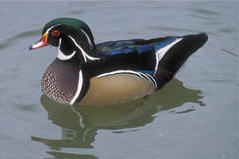 Wood
Duck
Aix sponsa
Wood
Duck
Aix sponsa
The Wood Duck is one of America’s best-loved waterfowl. The primary expression of this affection is the providing of nest boxes for this species, which originally nested in tree cavities. Such boxes have allowed the Wood Duck’s breeding range to spread into southern California. Once only a rare winter visitor to San Diego County, the Wood Duck is now also a local breeding resident, helped in part by releases of captive-reared birds.
Breeding distribution: The primary center for the Wood Duck in San Diego County is Santee Lakes (O12/P12), where counts in summer range as high as 32 on 23 July 1999 (F. Shaw). From there the ducks have spread to borrow pits in the San Diego River between Santee and Lakeside (P13; up to 12, including chicks, on 30 April 1998, W. E. Haas) and Lindo Lake, Lakeside (P14; female with four chicks 9 May 2001, N. Osborn). The Santee Lakes population is presumably the source of Wood Ducks dispersing west to Lake Murray (Q11; up to two on 26 April 2000, M. Billings) and east as far as the upper end of Loveland Reservoir (Q16; three on 13 June 2001, J. K. Wilson). From Santee Lakes Wood Ducks have been seen repeatedly flying northwest, far up West Sycamore Canyon, in the direction of no nearby water (P. Unitt).
The Wood Duck’s other San Diego County nesting sites are Cuyamaca Lake (M20; up to 14, including young, on 6 August 1999, A. P. and T. E. Keenan) and Wynola (J19; up to five, including a pair, on 8 May 1999; chick on 19 June 1999, S. E. Smith). At Cuyamaca the birds have raised about 80 chicks since they were introduced in 1994, but by 2003 the population was only about 12 individuals, their nesting success and survival being low through successive years of drought (H. Marx pers. comm.).
Wood Ducks near human habitation elsewhere in late spring and summer may have been domesticated: three in Valley Center (G11) 15 May 1997, one at Ramona (K15) 25 May 1998 (M. and B. McIntosh), and two at Pacific Beach (Q7) 7 May 2000 (L. Polinsky). But individuals at or near the Santa Margarita River mouth (G4/G5) 12 July 1998, 16 July 1999, and 13 May 2000 (P. A. Ginsburg) and along the San Luis River near the Forest Service picnic area (G16) 31 May 1999 (W. E. Haas) and 21 May 2001 seem more likely to have been natural pioneers.
Nesting: Primitively, Wood Ducks nested in cavities in trees over or near water. Nest boxes have been used widely in the effort to increase the species’ population, and the species’ establishment in San Diego County was dependent on them. Our sightings of chicks suggest the Wood Duck lays from about 1 April to about 1 June, though the birds have been seen around nest boxes at Santee Lakes as early as 11 February.
Migration: With the Wood Duck’s establishment as a breeding bird in San Diego County, its migration schedule here is no longer well defined. But all, or almost all, migrants occur from October through March. The 13 records for the Anza–Borrego Desert range from 16 October (1994, one at Lower Willows, D23, L. Clark et al.) to 21 January (1998, one at Scissors Crossing, J22, E. C. Hall).
Winter: The Wood Ducks at Santee Lakes remain year round, in numbers up to 55 on 28 December 1998 (E. Post). Some, at least, remain at Cuyamaca Lake and Wynola through the winter as well. Our high winter counts at those sites were four on 14 December 1999 (A. P. and T. E. Keenan) and two on 27 December 1999 (A. Young), respectively. Most of the Wood Ducks at Cuyamaca, however, move to other sites for the nonbreeding season (H. Marx pers. comm.).
Wood Ducks originating farther north are widely but sparsely scattered over San Diego County. The largest flocks noted during the atlas period were five at Ross Lake (B7) 18 February 2002 (K. L. Weaver), five in Escondido Creek near Elfin Forest Lake (K9) 9 January 1999 (L. E. Taylor), 12 in a pond along Viejas Creek, Alpine (P17), 8 February 2000 (M. B. Stowe), and 10 in Mission Valley (R9) 11 January 1999 (J. K. Wilson). The only reports of greater concentrations are from Lake Henshaw Christmas bird counts 23 December 1985 (13) and 19 December 1988 (30).
Except for the two cited under Migration, all records from the Anza–Borrego Desert are from artificial ponds from the Borrego Valley and are of no more than two birds.
Conservation: After being nearly extirpated from California in the early 20th century (Grinnell et al. 1918), the Wood Duck has enjoyed a renaissance throughout its range. A federal ban on hunting Wood Ducks from 1918 to 1941 allowed the recovery to begin, and the provision of nest boxes has contributed since. In San Diego County the species was introduced at Cuyamaca Lake. Six birds raised at Sea World were released in 1994, another six in 1995, and another five in 2002 (H. Marx pers. comm.). At Santee Lakes, on the other hand, there may have been no deliberate introduction. Wood Duck enthusiasts noticed the birds, put up boxes, and the birds colonized, as they have also in the Prado Basin and at Lake Elsinore, Riverside County (J. Brown pers. comm.). At ponds with domestic ducks Wood Ducks often become tame and remain year round, planting a nucleus for a breeding population if nest boxes are provided. If lacking such boxes the birds may prospect for nest sites in unsuitable man-made structures: near Viejas Creek a female Wood Duck came down a chimney (H. Marx pers. comm.).
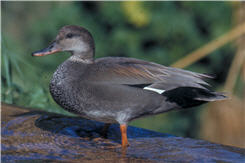 Gadwall Anas
strepera
Gadwall Anas
strepera
Like other puddle ducks, the Gadwall prefers shallow fresh and brackish water. Since the 1960s, it has increased greatly as a wintering bird, becoming abundant in the coastal lagoons, and has colonized as a breeding species. This colonization represents a southward spread of the Gadwall’s breeding range, which continued on to northwestern Baja California after covering San Diego County (Erickson et al. 2002).
Breeding distribution: San Diego’s Gadwalls are strongly concentrated in the coastal lagoons of the north county. During the breeding season our peak counts in this area, often including young, were 60 at the Santa Margarita River mouth (G4) 26 July 1998 (B. Peterson), 100 in the west basin of Buena Vista Lagoon (H5) 14 July 1998 (C. C. Gorman), 80 in the west half of Batiquitos Lagoon (J6) 15 May 1998 (M. Baumgartel), and 50 at San Elijo Lagoon (L7) 26 June 1999 (J. Ciarletta). In south-coastal San Diego County the Gadwall breeds at least in the Tijuana River estuary (V10/W10; up to 20 on 16 May 1998, B. C. Moore) and the San Diego Bay salt works (U10/V10; seven nests in 1997, M. R. Smith; average of 12 and maximum of 50 individuals in June 1993, Stadtlander and Konecny 1994).
Breeding or summering Gadwalls occur also at many ponds and well-vegetated reservoirs inland, especially in the lower Santa Margarita and San Luis Rey River valleys (up to 20 at O’Neill Lake, E6, 4 July 2000, P. A. Ginsburg; 25 at Whelan Lake, G6, 17 June 1997, D. Rorick). Warner Valley proved to be a minor center for the Gadwall, with the birds using ponds and marshy areas throughout the valley as well as Lake Henshaw (G17), which had up to 13, including young, 17 July 1998 (C. G. Edwards). Gadwalls summer, apparently irregularly, at San Diego County’s highest lakes, Cuyamaca (M20; up to two on 26 May 1998, B. C. Moore) and Big Laguna (O23; two on 24 July 1998, E. C. Hall, and 7 July 2001, J. R. Barth). The summer range extends slightly onto the east slope of the mountains in McCain Valley (R26, two on 6 May 2001; S26, two on 9 June 2001, P. Unitt) and at Tule Lake (T27; up to 10 on 6 June 2000, J. K. Wilson).
Nesting: Gadwalls nest on the ground, hiding the nest in dense low vegetation near water. In coastal San Diego County stands of pickleweed are the usual nesting habitat. Our dates for nests with eggs ranged from 1 May to 18 July, but we saw chicks as early as 2 May, implying egg laying as early as about 6 April.
Migration: With the Gadwall’s increase as a breeding species in San Diego County, its migration schedule is less distinct than formerly. Nevertheless, fall arrival is in late October or November, later than that of other puddle ducks. Quarterly surveys at Batiquitos Lagoon in 1997 found no Gadwalls at Batiquitos Lagoon on 27 and 28 October (Merkel and Associates 1997), though the species winters there commonly. On the basis of monthly surveys done in the early part of each month, King et al. (1987) found Gadwall numbers at San Elijo Lagoon to be at low summer levels in October but at high winter levels in November. Records for the Anza–Borrego Desert range from 26 October (1988, four at the Borrego Springs sewage pond, H25) to 15 March (1983, one at Lower Willows, D23, A. G. Morley). Spring departure is largely in April: numbers are at high winter levels early in that month but then drop quickly.
Winter: In winter as in the breeding season, the Gadwall is most abundant in northern San Diego County’s coastal lagoons. Our counts there ranged up to 450 in the west basin of Buena Vista Lagoon 22 December 2001 (J. Determan), 227 at San Elijo Lagoon 26 December 1999 (R. T. Patton), and 138 at the San Dieguito River estuary (M7) 13 February 1999 (D. R. Grine). In the tidal salt water of Mission and San Diego bays the Gadwall is irregular, generally uncommon, and restricted to shallow marshy areas. Inland, it is considerably more widespread and abundant in winter than in summer, with up to 117 in the upper ponds of Santee Lakes (O12) 13 February 1999 (I. S. Quon) and 100 at Swan Lake (F18) 29 December 1997 (G. L. Rogers). We found it wintering repeatedly as high as 5400 feet elevation at Big Laguna Lake (O23; up to 60 on 24 December 2001, P. Unitt). In the Anza–Borrego Desert the few winter records are all from ponds in the Borrego Valley and of no more than four individuals, as at the Roadrunner Club (F24) 15 December 1991 (A. G. Morley).
Conservation: Over the second half of the 20th century, over much of North America, the Gadwall increased and spread (LeSchack et al. 1997). In San Diego County, the species was just a winter visitor until 1971, when Alice Fries discovered a brood of chicks at Buena Vista Lagoon (AB 25:906, 1971). It spread rapidly over the next two decades, throughout the county’s coastal slope. Winter numbers also increased over this period. King et al. (1987) observed an increase at San Elijo Lagoon from 1973 to 1983. From 1961 to 1980 the San Diego Christmas bird count averaged 5.6 Gadwalls and sometimes missed the species. From 1989 to 1996 the average was 221. Similarly, the Oceanside count averaged 56 from 1975 to 1979 but 323 from 1989 to 2002. Though the Gadwall takes advantage of many artificial bodies of water, the change seems less likely due to local habitat changes than to broader forces such as regulation of hunting. The increase could reverse, too: from 1997 to 2002 numbers on the San Diego Christmas bird count were on the decline, averaging 63 during this interval.
Taxonomy: Gadwalls in both North America and Eurasia are nominate A. s. strepera Linnaeus, 1758.
Of the birds with a primarily Eurasian distribution that reach southern California, the Eurasian Wigeon is the most frequent. In San Diego County several are found each winter, always with flocks of American Wigeons.
Winter: The Eurasian Wigeon may turn up wherever the American Wigeon flocks in large numbers. Locations for the species are well scattered over the coastal slope, both along the coast itself and well inland. Usually only a single Eurasian Wigeon is noted among a flock of Americans, but there are many records of two individuals together and a few of three, as in the Tijuana River valley 11 March 1989 (J. O’Brien), at Mesa Grande (H17) 27 December 1999 (K. L. Weaver), and at Lake Henshaw (G17) in 1983, 1985, and 1986 (R. Higson, AB 27:337, 1983).
The Eurasian Wigeon is now an annual visitor to San Diego County. During the five-year atlas period the number found each winter ranged from four in 2001–02 to nine in 1999–2000. It is likely that many of the birds return to the same wintering site year after year. Such returnees presumably accounted for the repeated observations along San Marcos Creek near Rancho Santa Fe Road (J8; up to two 26–28 December 1999, W. E. Haas, E. C. Hall), in the San Diego River flood-control channel (R7/R8; often two individuals), and the Sweetwater River flood-control channel (T10/T11; one on four consecutive San Diego Christmas bird counts).
Migration: November through March is the main season for the Eurasian Wigeon in San Diego County. A somewhat increased frequency of sightings in February and March may reflect spring migration. Extreme dates are 29 September (1985, San Elijo Lagoon, L7, J. L. Coatsworth, AB 40:158, 1986) and 29 April (1996, Batiquitos Lagoon, J7, P. A. Ginsburg, NASFN 50:332, 1996).
Conservation: By the turn of the millennium the Eurasian Wigeon was being found considerably more often than in the 1960s and 1970s. It is unclear whether this apparent change is the result of more observers looking in more places or of the Eurasian Wigeon’s sharing in the increase of the American Wigeon.
Taxonomy: The Eurasian Wigeon hybridizes with the American regularly. California may be a likely area for such hybrids to be seen if they result from Eurasian Wigeons straying into the breeding range of the American, crossing with Americans, then migrating south with flocks of Americans along the Pacific coast. Sightings of hybrids in San Diego County are from Lake Henshaw 24 February 1985 (G. McCaskie, AB 39:210, 1985) and south San Diego Bay 10 December 1988 and 5 December 1992 (G. McCaskie, AB 43:365, 1989; 47:300, 1993).
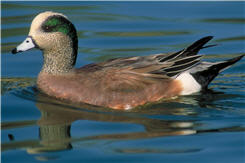 American
Wigeon Anas
americana
American
Wigeon Anas
americana
Though usually classified in the same genus as the dabbling ducks, the American Wigeon differs somewhat in its behavior. It spends considerable time out of the water grazing on terrestrial vegetation. In San Diego Bay it feeds principally on eelgrass. Because of these habits the wigeon is more widely distributed in San Diego County than related ducks. It is preadapted to that novel habitat now so widespread here—the golf course.
Winter: After the Mallard, the American Wigeon is San Diego County’s most widespread duck. It often occurs in numbers in places where other ducks are few or none, especially golf-course ponds (e.g., 60 at the Shadowridge Country Club, Vista, I8, 2 March 2001, C. H. Schork; 420 at Singing Hills, Q14, 5 December 1999, N. Perretta). Nevertheless, coastal wetlands with natural vegetation remain important to the wigeon: our high counts in these habitats ranged up to 387 at San Elijo Lagoon (L7) 26 December 1999 (R. T. Patton), 500 in the San Diego River flood-control channel (R8) 24 December 1997 (P. Unitt), and 500 along the Chula Vista shore of San Diego Bay (U10) 16 December 2000 (B. C. Moore). The last area supports San Diego’s most extensive remaining beds of eelgrass.
Some other sites wigeons use heavily are Lake Henshaw (G17; up to 450 on 21 December 1998, J. O. Zimmer), the Wild Animal Park (J12; up to 500 on 30 December 1999, D. and D. Bylin), and Lake Hodges (K10/K11; up to 400 on 11 February 1998, R. L. Barber). Even small lakes in the mountains attract small numbers of wigeons (e.g., 16 in Lower Doane Valley, D14, 7 January 2000, P. D. Jorgensen; up to 40 at Big Laguna Lake, O23, 23 February 2002, K. J. Winter). Because of its use of golf-course ponds, the American Wigeon is the most numerous waterfowl in the Borrego Valley, as judged on the basis of Anza–Borrego Christmas bird counts. The count has yielded as many as 109 on 19 December 1999; the highest number at a single site was 85 at the Roadrunner Club (F24) 30 January 2000 (P. D. Jorgensen).
Migration: The American Wigeon arrives slightly later than most other dabbling ducks that occur in San Diego County as winter visitors. The earliest arrivals are at the end of August, exceptionally 15 August (2003, one at the Sweetwater River mouth, T10, J. R. Barth), but few birds arrive before late September. Maximum numbers are not reached until November. Spring departure may begin in February; it continues through the first half of April, with numbers as high as 200 at the upper end of Sweetwater Reservoir (S13) as late as 10 April (1997; P. Famolaro) and 60 in the San Diego River flood-control channel as late as 15 April (1999; J. R. Barth). Almost all depart soon after this date, but a few migrants may still be seen in the first week of May (13 near Mesa Grande, I17, 5 May 1999, D. C. Seals).
During the atlas period, from mid May through early July, we recorded summering stragglers of the American Wigeon on 10 occasions—an unexpectedly high number for a species not known to nest anywhere in southern California. These records were well scattered from the coast to just over the mountain crest in upper San Felipe Valley (H20; one on 23 May 1999, A. P. and T. E. Keenan). Our largest concentration of summering wigeons was five at Whelan Lake (G6) 19 July 2001 (J. Smith). King et al. (1987) found summering wigeons at San Elijo Lagoon three times 1973–83, maximum 15 on 7 June 1981.
Conservation: Over the long term, it is unclear, from the American Wigeon’s point of view, how the gain of lawns and artificial ponds has balanced the loss of natural wetlands. The chemicals used on golf courses may pose a threat to wigeons as well as to other wildlife around them. The organophosphate insecticide Diazinon, used on golf courses, was responsible for at least three mass die-offs of American Wigeons in southern California (Littrell 1986). Sale of this chemical after 2004 has been banned, but other pesticides have been invented to replace it.
Recent trends in American Wigeon numbers on Christmas bird counts have been approximately flat in the Oceanside, Rancho Santa Fe, and Lake Henshaw circles but definitely up in the San Diego, Escondido, and Anza–Borrego circles. In the last two cases, the birds’ use of artificial habitats is clearly responsible for the increase. King et al. (1987) observed an increase at San Elijo Lagoon from 1973 to 1983. Improved water quality in San Diego Bay allowed the extent of eelgrass there to increase from at least the mid 1980s to 2000 (M. Perdue pers. comm.). In the latter year the coverage of eelgrass reached 1600 acres, the maximum currently possible. The wigeon’s increase on San Diego Bay likely followed the increase in eelgrass.
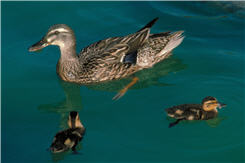 Mallard Anas
platyrhynchos
Mallard Anas
platyrhynchos
The Mallard is San Diego County’s most widespread duck. Over the final third of the 20th century its population exploded, the birds taking advantage of any water from large reservoir to intermittent creek. As a result, the Mallard is now a common, locally abundant, year-round resident. It provides a counter example to the general principle that birds nesting on the ground retreat from urbanization.
Breeding distribution: The Mallard has by far the widest distribution in San Diego County of any breeding duck. Hardly any pond on the coastal slope now lacks the species. The largest numbers are seen where domestic Mallards have been released, as at O’Neill Lake (E6; 200 on 30 July 2001, P. A. Ginsburg), Miramar Lake (N10; 212 on 5 July 1999, A. and G. Kroon), and Sweetwater County Park, Bonita (T12; 300 on 14 June 1999, T. W. Dorman). But there is no longer a clear-cut distinction between domestic and wild Mallards. Many Mallards nesting in urban areas bear no sign of domestication and fly strongly. Every evening, speeding over the traffic clogging Highway 163, flocks commute from Balboa Park to Mission Valley.
A few Mallards nest where the only water available is salt, as at the Chula Vista Wildlife Reserve and salt works in south San Diego Bay, regular sites for the species (Stadtlander and Konecny 1994, M. R. Smith, R. T. Patton). Most Mallards, though, nest around brackish or fresh water. Some are in urban settings where the only possible nest sites are under ornamental shrubbery, such as a cement-lined channel near Goodland Acres Park, Spring Valley (R12; female with chicks 12 July 1998, P. Unitt). Some are along creeks deep in the wilderness, such as San Mateo Canyon (A3; family of five on 18 June 1998, J. M. Wells, J. Turnbull).
The breeding range spills onto the desert slope in San Felipe Valley (H20/I21; young on 27 July 2000, J. O. Zimmer) and in southeastern San Diego County, where the birds range east to Jacumba (up to five on 22 April 1999, F. L. Unmack). Our most interesting Mallard nesting was in the wet spring of 1998, when San Felipe Creek flowed farther than usual, reaching the mouth of Sentenac Canyon (I23). Here P. K. Nelson found a female and five downy ducklings on 26 May. The Mallard has never been confirmed nesting in the Borrego Valley, though such nesting is possible around golf-course or sewage ponds. Occasional birds occur in this area late in the spring, as late as 27 May (2001, four at the Roadrunner Club, F24, M. L. Gabel). Three records from the riparian oasis of Lower Willows along Coyote Creek (D23) include a bird there 4 July 1999 (K. Wilson, B. Getty). Three juveniles at Butterfield Ranch (M23) 22 May 2001 (P. K. Nelson) had likely already dispersed from elsewhere, as this was our only breeding-season record from this site.
Nesting: Mallards nest in a depression on the ground, using surrounding or overhanging vegetation to screen the nest from predators. Nevertheless, predation is frequent. The chicks follow the female to water soon after hatching. Our dates for nests with eggs ranged from 29 March to 7 June, but on the basis of several sightings of chicks as early as 30 March, laying as early as the first week of March is not rare. One sighting of chicks as early as 22 March (1997, Lake Murray, Q11, N. Osborn) suggests occasional laying in mid February.
Migration: Though the Mallard is highly migratory over much of its range, it is unclear how much of this migration reaches San Diego County. Just to the east, around the Salton Sea, the Mallard is largely a winter visitor, occurring primarily from September to April (Patten et al. 2003). But in San Diego County Mallard numbers at many localities form no clear seasonal pattern. At some places the species is more numerous in winter, but at others, including those best studied with regular counts, San Elijo Lagoon (King et al. 1987) and the salt works (Stadtlander and Konecny 1994), it is somewhat more numerous in summer.
Winter: The Mallard’s winter distribution in San Diego County is similar to its breeding distribution but slightly less extensive. We recorded the species as at least possibly breeding in 44 squares where we missed it in winter, versus only 15 for the reverse comparison. It is likely that wintering Mallards are drawn to places where domesticated—or self-domesticated—ducks reside. Our highest winter counts were from such sites: the Wild Animal Park (J12; 1000 on 30 December 1999, D. and D. Bylin; 679 on 2 January 1999, K. L. Weaver), Balboa Park (R9; 368 on 15 December 2001, V. P. Johnson), and Bonita (400 on 18 December 1999, E. Mirsky). The Mallard winters as high in the mountains as Big Laguna Lake (O23; up to 25 on 24 December 2001, P. Unitt) and in the desert at ponds in the Borrego Valley (up to 56 in Borrego Springs, G24, 17 December 2000, S. and J. Berg) and at Butterfield Ranch (up to seven on 18 February 2000, H. H. Williams).
Conservation: Over most of North America, the population of the Mallard was fairly stable through the second half of the 20th century, though there was a spike upward from 1993 to 1999 (Drilling et al. 2002). In San Diego County, by contrast, from the 1960s to the 1990s the Mallard population increased exponentially. From 1960 to 1969 the San Diego Christmas bird count averaged 6.4 Mallards; from 1992 to 2002 this average was over 100 times greater at 732. For the Oceanside count the averages over the same intervals were 13.2 and 800. Over their shorter terms the Rancho Santa Fe and Escondido counts show similar trends.
Nesting in the 19th century, recorded by Cooper (1880), Sharp (1907), and Willett (1933), shows that San Diego County has long been part of the Mallard’s breeding range. Stephens (1919a) called the species an “occasional” summer resident; Sams and Stott (1959) said “resident in small numbers.” The rapid increase is likely due to a combination of factors: importation of water, creation of ponds, cessation of hunting at many sites, release of domestics, and self-domestication.
Taxonomy: Anas p. platyrhynchos Linnaeus, 1758, is the only subspecies of the Mallard in San Diego County, although there are three equivocal records of the Mexican Duck, A. p. diazi Ridgway, 1886, from elsewhere in California (Patten et al. 2003).
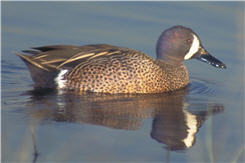 Blue-winged
Teal
Anas discors
Blue-winged
Teal
Anas discors
Though the Blue-winged Teal is regular in San Diego County in small numbers, at least from October to April, it is scarce enough that the species can never be expected—except at Famosa Slough and the San Diego River flood-control channel. The Blue-winged is very closely related to the Cinnamon Teal, and in San Diego the Blue-winged is almost always seen in the company of the Cinnamon.
Winter: Because the Blue-winged Teal’s spring migration apparently starts in late January, the map shows for wintering only locations where the species was noted 1 December–20 January; later records are mapped as migrants.
The San Diego River flood-control channel and nearby Famosa Slough (R8) are by far the primary spots for wintering Blue-winged Teals in San Diego County. Typical numbers at both places are from five to ten, but up to 60 have been noted in the flood-control channel (9 January 2001, R. E. Webster, NAB 55:227, 2001), and up to 20 have been noted at Famosa Slough (1 and 6 January 2000, J. A. Peugh). Occasionally the birds extend to nearby Mission Bay (Q8; six on 16 January 2000, J. C. Worley).
Elsewhere wintering Blue-winged Teals are rather rare; at other sites our counts during the atlas period did not exceed four. Their locations include south San Diego Bay, the coastal lagoons, and lakes and ponds scattered through the coastal lowland. Though we did not encounter any wintering at higher elevations from 1997 to 2002, there are two records each of two individuals on Lake Henshaw Christmas bird counts, 23 December 1985 and 31 December 1989. There are also three winter records from the Borrego Valley, of one at the Borrego sewage ponds (H25) 18 January 1993 (A. G. Morley), one on the Anza–Borrego Christmas bird count 20 December 1987, and two on the count (on ponds at Ram’s Hill, H25) 21 December 1997 (R. Halford)
Migration: Spring migration of the Blue-winged Teal follows closely behind that of the Cinnamon Teal. The birds are probably on the move by late January (four at Crestwood Ranch, R24, 22 January 2000, A. P. and T. E. Keenan, J. S. Larson), certainly by early February (14 on Barrett Lake, S18/S19, 5 February 2000, R. and S. L. Breisch). During the atlas period we did not find the Blue-winged Teal noticeably more numerous in spring migration than in winter, but we did find migrants occasionally at ponds isolated in dry regions such as Lake Domingo (U26; two on 9 February 2000, F. L. Unmack) and San Felipe Valley (I21; five on 26 April 1999, J. O. Zimmer). Wintering birds or migrants evidently remain to late April (nine in the San Diego River flood-control channel 27 April 1999, M. B. Stowe).
The Blue-winged Teal’s fall migration is poorly known because of the species’ close similarity to the Cinnamon Teal when in eclipse plumage. But fall migrants evidently begin returning as early as 23 July (Unitt 1984).
Breeding
distribution:
The Blue-winged Teal has never been confirmed breeding in San Diego County,
though it has been as near as Bolsa Chica, Orange County (Hamilton and Willick
1996). Such breeding is quite possible in San Diego County, however, as
the species remains occasionally through the summer. From 1997 to 2001 we
noted the Blue-winged Teal seven times from May through early July. All
these birds were along or near the coast, except for one at Swan Lake (F18) 24
June 2000 (C. G. Edwards). Only one of these records, however, is of more
than one individual (two at Los Peñasquitos Lagoon 2
June 2001, K. Estey).
Conservation: By the end of the 20th century the number of Blue-winged Teals wintering in San Diego County had increased over that in the 1970s. The change equalized the formerly noticeable difference between the species’ status in winter and in spring migration.
Taxonomy: The Blue-winged hybridizes occasionally with the Cinnamon Teal, and such hybrids have been noted in San Diego County during spring migration.
 Cinnamon
Teal
Anas cyanoptera
Cinnamon
Teal
Anas cyanoptera
Unlike the Mallard and Gadwall, the Cinnamon Teal has enjoyed no great population increase in San Diego County. Instead, the population may be slipping with the loss of the shallow natural wetlands that the teal favors. Deeper reservoirs without a fringe of low wet vegetation are inferior habitat. Currently, the Cinnamon Teal is common as a spring migrant, generally uncommon as a breeding summer resident, and fairly common as a fall migrant and winter visitor.
Breeding distribution: Nesting Cinnamon Teals are widely scattered on the coastal slope of San Diego County and extend east over the divide on the Campo Plateau and possibly in San Felipe Valley. But they are seldom common. During the narrow interval from mid May to early July when migrants are not expected, our high counts were of 16 (including young) at O’Neill Lake (E6) 4 July 2000 (P. A. Ginsburg), 15 (including young) on Sweetwater Reservoir (S12) 8 June 1998 (P. Famolaro), 16 at the upper end of Lake Morena (S22) 2 July 2000, chicks there 31 May 1998 (R. and S. L. Breisch), and 20 at Tule Lake (T27) 21 June 2000 (J. K. Wilson). Other known nesting sites include Lake Henshaw, the Mesa Grande area, Cuyamaca Lake, and Big Laguna Lake, so in San Diego County the Cinnamon Teal is just as likely to nest well inland as in the coastal lagoons and lowland. Even intermittent ponds can support the species: at a pond 2 miles south of Bankhead Springs (U27), empty in dry years, the Cinnamon Teal has nested repeatedly (F. L. Unmack). Nesting is not confirmed in the Borrego Valley but possible. In 1998, at the Borrego sewage ponds, six were in courtship display 5 April 1998 (P. D. Jorgensen) and one remained until 23 May (H. L. Young, M. B. Mosher).
Nesting: Like other dabbling ducks the Cinnamon Teal nests on the ground near water, in and often under dense vegetation. From 1997 to 2001 almost all our confirmations of the species’ breeding were sightings of chicks, on dates ranging from 24 April to 3 August. This interval suggests the species lays at least from late March to June. Cooper (1880) collected a female with an egg in its oviduct near San Luis Rey (G6) 22 June 1861, and G. McCaskie found a nest with eggs at Lake Cuyamaca 25 June 1978.
Migration: In San Diego County the Cinnamon Teal is considerably more widespread and numerous as a migrant than as either a breeding bird or winter visitor. It is also one of the area’s earliest migrants. Its numbers increase rapidly in late January, and our highest count during the atlas period was of 300 on ponds near the lower Santa Margarita River (G5) 25 January 1998 (B. C. Moore). During migration, Cinnamon Teals visit salt water, which they avoid at other seasons. Quarterly surveys of south San Diego Bay outside the salt works 1988–89 found the species only in early spring (maximum 22 on 7 February 1989, Macdonald et al. 1990). Weekly surveys within the salt works 1993–94 found it February–April and in September almost exclusively (maximum 27 on 24 February 1993, Stadtlander and Konecny 1994).
In the Anza–Borrego Desert the Cinnamon Teal is noted most often from February to early April, with high counts of 20 at the Borrego Springs sewage ponds (H25) 9 February 1993 (A. G. Morley) and 4 April 1997 (H. L. Young, M. B. Mosher). Eleven in Borrego Springs (G24) 4 May 2000 (P. D. Ache) suggest the teal’s spring migration extends into early May. Away from artificial ponds, the birds stop occasionally at natural oases and even in the shade of boulders, far from water, to wait out the day. To their great surprise, atlas observers encountered Cinnamon Teals in rocky waterless desert twice: 15 were in Bow Willow Canyon (P26) 19 February 2001 (A. P. and T. E. Keenan); three were 3.5 miles southwest of Ocotillo Wells (J28) 4 April 2000 (J. R. Barth).
Fall migration extends mainly from mid July (40 at Lake Henshaw 17 July 1998, C. G. Edwards) to October. Four fall records from the Anza–Borrego Desert range from 15 August to 30 September.
Winter: Because of the species’ migration schedule, the map of the Cinnamon Teal’s winter distribution shows only records from 1 December to 14 January. The Cinnamon Teal winters mainly in the coastal lowland, on fresh or brackish water. Sites of exceptional concentration are the Wild Animal Park (J12; up to 200 on 30 December 1999, D. and D. Bylin; 72 on 30 December 2000, K. L. Weaver) and sewage ponds near the Santa Margarita River mouth (G5; up to 150 on 8 January 2000, R. E. Fischer). Elsewhere we found fewer than 50 and seldom more than 20. A few appeared in the foothills and mountains, twice even as high as 5400 feet elevation at Big Laguna Lake (O23; one on 6 December 1999, D. S. Cooper; four on 24 December 2001, P. Unitt). Wintering Cinnamon Teals also show up rarely on ponds in the Borrego Valley. The species has been recorded on five of 19 Anza–Borrego Christmas bird counts 1984–2002, with a maximum of six on 22 December 1996.
Conservation: The status of the Cinnamon Teal in San Diego County seems not to have changed greatly through history. Loss of shallow natural wetlands, ideal Cinnamon Teal habitat, may have been offset by the importation of water. Numbers on San Diego Christmas bird counts have gyrated, from a low of two in 1971 to a high of 219 in 1992 and back down to nine in 2000 and 2002. But these changes are likely due to variations in water levels and habitat changes within that circle; other counts in the county have been more stable. Nevertheless, there could be some broader decline: the numbers King et al. (1987) reported as averages at San Elijo Lagoon 1973–83 were seldom equaled anywhere in the county 1997–2002. The 42 young with 5 adult females at the east end of Lake Hodges (K11) 19 June 1982 (K. L. Weaver) were not.
Taxonomy: All Cinnamon Teals in North America are A. c. septentrionalium Snyder and Lumsden, 1951. In addition to hybrid Cinnamon × Blue-winged Teals, a hybrid between the Cinnamon Teal and Northern Shoveler was reported from near Imperial Beach 1 March 1984 (E. Copper, AB 38:357, 1984).
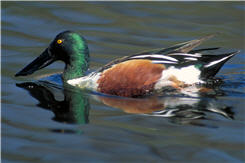 Northern
Shoveler Anas
clypeata
Northern
Shoveler Anas
clypeata
The Northern Shoveler is primarily a winter visitor to San Diego County, abundant in shallow water over a muddy bottom. Here the shovelers can use their spatulate bills to filter the water for seeds, snails, and plankton. Small numbers remain through the summer, but the shoveler is known to have nested in San Diego County only once.
Winter: The Northern Shoveler winters widely in San Diego County’s coastal wetlands and on its inland lakes. Certain lakes and lagoons, however, are sites of consistently large concentrations. The most important of these are O’Neill Lake (E6; up to 1000, as on 4 December 2000, P. A. Ginsburg), Windmill Lake (G6; up to 763 on 27 December 1997, P. Unitt), Whelan Lake (G6; up to 593 on 21 January 1998, D. Rorick), Lake Hodges (K10/K11; up to 655 on 22 December 2000, R. L. Barber), San Elijo Lagoon (L7; up to 2000 on 20 January 1998, A. Mauro), and Sweetwater Reservoir (S12/S13; up to 800 on 14 January 1999, P. Famolaro).
Though most common on fresh or brackish water, the shoveler also uses tidal mudflats and salt marshes, with up to 330 in south San Diego Bay 16 December 2000 (G. Moreland). If water is adequate, shovelers exploit seasonal wetlands and intermittently filled lakes such as Big Laguna (O23; 30 on 23 February 2002, K. J. Winter), Corte Madera (Q20/R20; 75 on 20 February 1999, G. L. Rogers), and the upper basin of Lake Morena (S21; 550 on 16 February 1998, S. E. Smith). In the Anza–Borrego Desert the shoveler is a rare visitor reported only from artificial ponds in the Borrego Valley (maximum five in the north Borrego Valley, E24, 5 December 1976, P. D. Jorgensen).
Migration: Northern Shovelers begin arriving in San Diego County in mid August, and their numbers increase through December (Unitt 1984, King et al. 1987). Yet, in weekly surveys of the south San Diego Bay salt works through 1993, Stadtlander and Konecny (1994) did not find shovelers in numbers until November. Spring departure is in March and April. Substantial numbers may remain as late as mid April (84 at Buena Vista Lagoon 13 April 1999, M. Freda), but almost all depart soon after that.
Breeding distribution: From May to July the Northern Shoveler is rare in San Diego County, but from 1997 to 2001 we noted it during these months in 11 areas. Summering birds were most frequent at Whelan Lake and Buena Vista Lagoon (up to seven on 29 May 2001, R. Gransbury). Particularly surprising were three on the Campo Plateau at Tule Lake (T27) 27 June 2001 (J. K. Wilson). Shovelers at Sweetwater Reservoir (S12/S13) 1–3 May 2000 (P. Famolaro) appeared paired, but otherwise we saw no suggestion of the species’ breeding in San Diego County. Alice Fries’ observation of five ducklings following their mother in the sewage pond at Camp Margarita (E5) 6 June 1978 is still the county’s only confirmation of shovelers nesting.
Conservation: The evidence for trends in shoveler numbers in San Diego County is contradictory. At San Elijo Lagoon, King et al. (1987) found no trend from 1973 to 1983, and the numbers we recorded there 1997–2002 seem consistent with the high levels of that earlier study (winter average 600 birds). The Rancho Santa Fe Christmas bird count, including San Elijo, shows no clear trend in shovelers. On the San Diego count, however, shovelers have increased, from an average of 161 from 1960 to 1985 to an average of 870 from 1997 to 2002. Yet on the Oceanside count the trend looks negative. On that count shovelers went from an average of 3105 from 1975 to 1984 to an average of 758 from 1997 to 2002. Unfortunately, the historical record is too poor to illuminate the species’ history further. But, with the development of most of the coastal floodplains and Mission and San Diego bays, many of the shallow and seasonal wetlands ideal for shovelers have been lost.
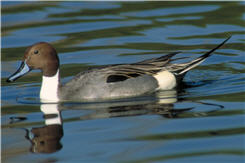 Northern
Pintail
Anas acuta
Northern
Pintail
Anas acuta
The
Northern Pintail was once the county’s most abundant dabbling duck, but its
numbers have dropped behind those of the American Wigeon
and Northern Shoveler, while those of the Mallard
have surged past it. But the pintail is still a locally common winter
visitor to shallow water both inland and along the coast. In late spring
and early summer it is uncommon. San Diego represents the southern tip of
its breeding range, but it has been confirmed nesting in the county only a few
times, none during the five-year atlas period.
Winter: Pintails are widespread in San Diego County but concentrate at rather few places. These include some of the north county lagoons, especially Batiquitos (660 on 6 January 1997, Merkel and Associates 1997; 352 on 2 January 1998, C. C. Gorman). In the southern half of the county the principal sites are northeastern Mission Bay (Q8; up to 165 on 21 December 1998, J. C. Worley), the San Diego River flood-control channel (R8; up to 500 on 24 December 1997, P. Unitt), south San Diego Bay (U10; 467 on 16 December 2000, D. G. Seay; V10; 400 on 18 December 1999, J. L. Coatsworth), and the Tijuana River estuary (V10/W10; 350 on 20 December 1997, S. Walens).
Major inland sites are the Wild Animal Park (J12; up to 582 on 2 January 1999, K. L. Weaver), Lake Hodges (K10/K11; up to 300 on 5 and 11 February 1998, R. L. Barber), Sweetwater Reservoir (S12/S13; up to 150 on 2 January 2002, P. Famolaro), and Sweetwater County Park, Bonita (T11; up to 150 on 19 December 1998, L. D. and R. Johnson). Pintails occur in smaller numbers at other lakes, provided their shores are not so steep they have little aquatic vegetation. We found no pintails in reservoirs installed in deep canyons, such as San Vicente and Loveland. The pintail winters at elevations as high as 5400 feet at Big Laguna Lake (O23; up to 30 on 23 February 2002, K. J. Winter) but is one of the scarcer ducks in the Anza–Borrego Desert. State park, Christmas bird count, and atlas databases contain only 10 records, all of single individuals except for an incongruous flock of 100 flying over the Carrizo Badlands 15 January 1971 (M. C. Jorgensen).
Migration: At north San Diego County’s coastal lagoons, pintails arrive in August and depart largely in March (King et al. 1987). In 1978, Batiquitos Lagoon was a major migration stop, with numbers reaching 2000 on 26 August (P. Unitt). In 1993, however, in the south San Diego Bay salt works, Stadlander and Konecny (1994) found none before October and few before November. Dates for the Anza–Borrego Desert range from 5 August (1973; one at Pena Spring, G23, ABDSP database) to 5 March (1991; one at the Borrego sewage pond, H25, A. G. Morley). On the coastal slope enough pintails summer that the schedule cannot be defined exactly, but atlas data suggest that few wintering birds remain after 1 April.
Breeding distribution: The Northern Pintail summers in San Diego County in small numbers. From 1997 to 2001 we noted it on 21 occasions between 15 April and 10 July. Some of these summering pintails were in coastal lagoons, up to two at San Elijo Lagoon (L7) 3 May 1999 (A. Mauro). On their monthly counts at San Elijo 1973–83, King et al. (1987) had a May–August average of 4.1 pintails. Other summering birds were at inland lakes, up to six in the southeast corner of the Lake Cuyamaca basin (M21) 16 June 1998 (P. D. Jorgensen). Though we saw pairs at Lake Cuyamaca (M20) 8 July 1998 (A. P. and T. E. Keenan), at the northeast corner of Lake Morena (S22) 31 May 1998 (R. Breisch), and at Sweetwater Reservoir repeatedly (P. Famolaro), during the atlas period we found no nests or chicks. The only published records of actual nesting in San Diego County are from Lake Henshaw (G17; “many hundred” young raised in 1926, fewer in 1927, Abbott 1928a), the Santa Margarita River mouth (G4; broods of chicks 16 June 1973 and 28 June 1974, A. Fries, AB 28:948, 1974), and the south San Diego Bay salt works (nest with eggs 9–29 May 1978, Unitt 1984).
Conservation: From the 1970s to the early 1990s the North American population of the Northern Pintail fell by over 50% (Austin and Miller 1995). There is evidence for change in San Diego County as well. The numbers King et al. (1987) recorded at San Elijo Lagoon from 1973 to 1983 (fall/winter average of 470) were not matched from 1997 to 2002 (maximum count 141 on 26 December 1999, R. T. Patton). The Rancho Santa Fe Christmas bird count, which includes San Elijo Lagoon, averaged 1300 pintails from 1983 to 1988 but 197 from 1997 to 2002. Numbers on the Oceanside count dropped precipitously with the new millennium. They averaged 538 from 1975 to 1993 but only 17 from 2000 to 2002. Some of this change, however, may be due to the birds shifting to a new wintering site. Numbers on the Escondido Christmas bird count have increased almost continuously since that count was established in 1986, as a result of pintails adopting the Wild Animal Park as winter habitat. Although the birds use these artificial ponds, conservation of natural shallow wetlands is as critical to the pintail as to many other water birds. Note the pintail’s absence from Agua Hedionda Lagoon (I6), which differs from the north county’s other lagoons by having been dredged.
 Green-winged
Teal
Anas crecca
Green-winged
Teal
Anas crecca
California’s smallest duck, the Green-winged Teal is a winter visitor to San Diego County. It is less numerous than most other dabbling ducks but still locally common. It shares both coastal wetlands and inland lakes with the other ducks, favoring shallow fresh and brackish water over salt. There are few records of stragglers remaining through the summer but only one old record of nesting.
Winter: The Green-winged Teal is widely distributed in San Diego County but at most sites the numbers are rather small. Flocks seldom number over 50 individuals. Along the coast, the species’ primary sites are the Santa Margarita River estuary (G4; up to 200 on 15 January 2001, P. A. Ginsburg), Batiquitos Lagoon (J7; up to 115 on 6 February 1998, C. C. Gorman), San Elijo Lagoon (L7; up to 170 on 26 December 1999, R. T. Patton), and Los Peñasquitos Lagoon (N7; up to 102 on 3 February 2002, S. E. Smith). Important freshwater sites in the coastal lowland are Lake Hodges (K10/K11; up to 240 on 26 December 1999, E. C. Hall) and the pond along Dairy Mart Road in the Tijuana River valley (V11; up to 150 on 20 December 1997, G. McCaskie).
Farther inland the Green-winged Teal is
irregular, as attested by its great variation on Escondido and Lake Henshaw Christmas bird counts. During the atlas
period our highest numbers in the foothills and mountains were 110 at Lake Henshaw (G17) 29 December 1997 (J. O. Zimmer), 50 in the
southeast corner of the Lake Cuyamaca basin (M21) 11
February 1998 (P. D. Jorgensen), and 40 at Barrett Lake (S19) 29 December 2000
(R. and S. L. Breisch).
In the Anza–Borrego Desert the Green-winged Teal is rare but more frequent than the Gadwall, Northern Shoveler, or Cinnamon Teal. Most records are from ponds in the Borrego Valley, with up to 10 at the Roadrunner Club (F24) 28 February 1999 (P. D. Jorgensen) and 12 at the Borrego sewage ponds (H25) 9 February 1993 (A. G. Morley).
At any one site in San Diego County the numbers of Green-winged Teals wintering vary much from year to year. But comparison of the results of San Diego County’s Christmas bird counts suggests little if any correlation among the counts.
Migration: The Green-winged Teal begins arriving in mid August but does not reach full abundance until December (Unitt 1984, King et al. 1987). Sightings at desert oases in the latter half of February show that spring migration begins by then (25 at Lower Willows, D23, 18 February 1982, P. D. Jorgensen; one at Butterfield Ranch, M23, 26 February 2000, E. C. Hall; one along Vallecito Creek between Mason and Vallecito valleys, M24, 27 February 1988, Massey and Evans 1994). Most Green-winged Teals depart in March and early April. From 1973 to 1983 King et al. (1987) found the species regularly into early May, but from 1997 to 2002 our only sighting later than 16 April was of one at Los Peñasquitos Lagoon 3 May 1998 (D. K. Adams, K. Estey).
Breeding distribution: King et al. (1987) noted the Green-winged Teal at San Elijo Lagoon on four occasions in June or July 1973–83, maximum five on 3 July 1983. During the atlas period we found no summering individuals. J. B. Dixon’s report of a “nest containing 11 pipped eggs” in the San Luis Rey River valley 18 May 1931 (Willett 1933) is still the only record of the Green-winged Teal nesting in California south of Kern County.
Conservation: Christmas bird count results suggest that in San Diego County the Green-winged Teal could be going into decline. From 1975 to 1984 the species’ average on the Oceanside count was 427, but from 1997 to 2002 it was 137. The Rancho Santa Fe count averaged 502 from 1981 to 1990 but 253 from 1997 to 2002. King et al. (1987) recorded a winter average of 220 on their monthly surveys of San Elijo Lagoon 1973–83, but our maximum count there during the atlas period was only 170. Over the species’ range as a whole, however, the Green-winged Teal increased through the second half of the 20th century (Johnson 1995).
Taxonomy: Anas c. carolinensis Gmelin, 1789, is the subspecies of the Green-winged Teal resident in North America. The nominate subspecies of the Old World, A. c. crecca Linnaeus, 1758, also reaches California as a rare visitor, being more frequent farther north. There are nine records from San Diego County, from Bonita (T11; 29 January–24 February 1962, AFN 16:364, 1962), San Elijo Lagoon (18–24 March 1973, AB 27:662, 1973), Batiquitos Lagoon (12 December 1973, AB 28:692, 1974), Lake Cuyamaca (M20; 11 March 1979 and 16 March 1980, AB 33:312, 1979 and 34:306, 1980), Lake Henshaw (5–12 February 1982, R. Higson, AB 36:330, 1982), and the San Diego River mouth (4 February–12 March 1989, G. McCaskie, AB 43:365, 1989; 17–19 February 1990, J. O'Brien, AB 44:328, 1990; 13 January–5 March 2001, P. E. Lehman, NAB 55:227, 2001). Also, an apparent hybrid crecca × carolinensis was at Bonita 4 January–1 February 1963 (AFN 17:358, 1963); it showed both the vertical white stripe of carolinensis and the horizontal white stripe of crecca.
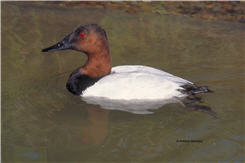 Canvasback Aythya
valisineria
Canvasback Aythya
valisineria
Unlike many wintering ducks, which return to the same sites year after year, the Canvasback is rather irregular. Almost everywhere it occurs it is usually uncommon, yet large flocks appear from time to time on some lakes and lagoons. Though the brackish lagoons of northern San Diego County are some of the Canvasback’s most consistent sites, the species is rare on the salt water of San Diego and Mission bays.
Winter: From 1997 to 2002 O’Neill Lake, Camp Pendleton (E6), was by far the principal site for the Canvasback in San Diego County. Counts there exceeded 150 every year of the atlas period and reached a maximum of 600 on 4 December 1999 (P. A. Ginsburg). The next most important site was Buena Vista Lagoon, where counts were at least 20 in the west basin (H5) in all five years and reached a maximum of 232 on 27 December 1997 (D. Rorick). Large numbers were fairly frequent at the Santa Margarita River mouth (G4; up to 250 on 8 February 2000, P. A. Ginsburg) and in the east basin of Batiquitos Lagoon (J7; up to 120 on 26 February and 18 December 1999, M. Baumgartel). The Canvasback is often found on lakes elsewhere in northwestern San Diego County, making this region the nucleus of the species’ distribution in the county.
Elsewhere the Canvasback is more scattered and less consistent. Lake Cuyamaca (M20) is one of the more regular sites, with up to 50 on 14 December 1999 (A. P. and T. E. Keenan). We also found the Canvasback repeatedly in southeastern San Diego County with up to 42 at Corte Madera Lake (Q20) 21 February 1999 (W. E. Haas), 76 in Round Potrero (T20) 23 December 1999 (L. J. Hargrove), and 40 at Tule Lake (T27) 5 January 2000 (F. L. Unmack). With the installation of ponds in the Borrego Valley the Canvasback has become a rare visitor in that area, with up to three individuals on golf courses in Borrego Springs (G24) 21 February 1999 (P. D. Ache) and 17 December 2000–21 January 2001 (S. and J. Berg).
Atlas participants saw one or two Canvasbacks on Mission Bay only twice and did
not find any on San Diego Bay. Various intensive surveys of San Diego Bay
1988–95 yielded only a single sighting, of three in the bay’s southeast corner
(U10) 26 November 1988 (Macdonald et al. 1990).
Migration: The Canvasback begins arriving in San Diego County in early November (Unitt 1984); arrival in October could be expected because the species has been found as early as 7 October at the Salton Sea (Patten et al. 2003). Spring departure is in March and early April. A count as high as 100 at O’Neill Lake 26 March 2001 (P. A. Ginsburg) was exceptionally late. Our latest spring migrant was one at Round Potrero 16 April 2000 (P. Unitt).
Summer stragglers have been recorded at Carlsbad 14 June 1982 (T. A. Meixner, AB 36:1015, 1982), Batiquitos Lagoon 29 July 1989 (J. Oldenettel, AB 43:1367, 1989), and Lake Cuyamaca (16 May 1964, G. McCaskie; 8 June 2000, J. D. Barr; 24 August 2002, J. R. Barth, P. Unitt).
Conservation: The Canvasback’s population rangewide, monitored closely because of the species’ popularity with duck hunters, has fluctuated considerably. It decreased from 1982 to 1995 but then rebounded (Mowbray 2002). The Canvasback’s decline at the Salton Sea has not been reversed (Patten et al. 2003). Any trend in San Diego County is obscured by the species’ irregularity.
 Redhead Aythya
americana
Redhead Aythya
americana
Hundreds of Redheads winter in Mission Bay. Flocks appear occasionally on lakes and lagoons elsewhere, but nowhere away from Mission Bay is the species consistently common. Though a diving duck, the Redhead prefers rather shallow water. It is mainly a winter visitor but also breeds in small numbers along the county’s north coast. San Diego County represents the southern tip of the species’ breeding range along the Pacific coast of North America.
Breeding distribution: From 1997 to 2001 the only sites where we confirmed Redheads nesting were sewage ponds along the Santa Margarita River between Pueblitos Canyon and Rifle Range Road (F5; 19, including chicks, 28 June 2000, R. E. Fischer, J. Morlan) and at Stuart Mesa Road (G5; 24, including chicks, 20 June 1999, R. E. Fischer). Other sites where the species is known to have bred are Whelan Lake (G6; chicks photographed 18 May 2003, J. C. Daynes), “San Luis Rey Valley” (eggs collected 11 May 1933, Willett 1933), Guajome Lake (G7; eggs collected 11 May 1936, WFVZ 2564), Santa Margarita River estuary (G4), Buena Vista Lagoon (H5/H6), Batiquitos Lagoon (J6/J7), San Elijo Lagoon (L7), and Los Peñasquitos Lagoon (N7; Unitt 1984). During the atlas period we saw Redheads, often in pairs, through the breeding season at all these sites except Los Peñasquitos. O’Neill Lake (E6; up to six on 2 July 1999, P. A. Ginsburg) and the mouths of Las Flores (E3; up to four on 17 May 1998, R. and S. L. Breisch) and Aliso (F4; pair on 1 July 2001, B. C. Moore) creeks are new sites of possible breeding. Numbers at all sites of possible breeding were usually five or fewer. The records with chicks excluded, our highest counts during the breeding season were of 15 in the east basin of Buena Vista Lagoon 16 May 1999 (L. E. Taylor) and 20 in the San Dieguito River estuary 10 July 1999 (D. R. Grine). The Redhead appears to be irregular at many of these sites.
A few late spring records elsewhere suggest the Redhead could nest occasionally in other parts of San Diego County. Two were at Turner Lake, Valley Center (G11), 15 May 1997 (L. Seneca), one was at Wynola (J19) 12 March–19 July 1999 (S. E. Smith), one was at Sweetwater Reservoir (S12) 4 May 1998 (P. Famolaro), and three were at Tule Lake (T27) 6 June 2001 (J. K. Wilson).
Nesting: Redhead nests are usually within dense marshes, often over water. Besides the two egg sets collected on 11 May, evidence for the Redhead’s nesting schedule in San Diego County comes from sightings of chicks, which range from 24 May to 27 August (A. Fries in Unitt 1984).
Migration: In fall, Redheads return in numbers by late October (68 at Batiquitos Lagoon 27 October 1997, Merkel and Associates 1997). In spring, they depart in March and early April. Forty were still in the San Diego River flood-control channel (R8) 15 April 1999 (J. R. Barth). Sixteen in northwest Mission Bay (Q7) 21 April 2000 (L. Polinsky) and three at Miramar Lake (N10) 26 April 1998 (P. Unitt) were late stragglers. Ten records from the Borrego Valley range from 11 November (1990, two at the Roadrunner Club, F24, E. H. Monsees) to 28 March (1999, one at Borrego Springs, G24, P. D. Ache).
Winter: Currently, Mission Bay is the center for wintering Redheads in San Diego County. Often the birds congregate in the low hundreds in southeast corner of the bay at the mouth of Tecolote Creek (R8). But they move around. Our highest count, of 1915 on 7 December 1998, was in the northeast quadrant of the bay (Q8; J. C. Worley). Sometimes the birds move across Sea World Drive to the San Diego River flood-control channel (up to 450 on 9 December 2000, P. A. Ginsburg).
At other places numbers of wintering Redheads vary wildly. Buena Vista and Batiquitos lagoons are among the more regular sites, and numbers there are sometimes large, with up to 722 at Batiquitos 7 January 1997 (Merkel and Associates 1997). But numbers on Oceanside Christmas bird counts, which include both these lagoons, have varied from a high of 442 in 1996 to a low of two in 1979. Similarly, numbers on the Rancho Santa Fe count, which encompasses San Elijo, San Dieguito, and Los Peñasquitos lagoons, have varied from 97 in 1987 down to one in 1980 and 2001.
Farther inland the Redhead is even more sporadic. Miramar Lake (N10) was the only inland site where we found the species regularly (up to 25 on 1 February 2000, G. Grantham). Since the inception of the Lake Henshaw Christmas bird count in 1981, the Redhead has been recorded on fewer than 50% of the counts. Yet our largest inland flock during the atlas period, 100 at Swan Lake (F18) 21 December 1998 (G. L. Rogers), gave this count its only total greater than ten.
Conservation: The sharp fluctuations from year to year in numbers of Redheads on San Diego County Christmas bird counts are not coordinated among the counts. The variations could thus be due as much to flocks shifting from site to site within the county as to annual variation in the numbers migrating into the county from the north. The breeding population has remained at a low level for decades without conspicuous change.
Ring-necked Duck Aythya collaris
The Ring-necked Duck differs from other diving ducks in its preference for small ponds and avoidance of coastal bays and lagoons. It is a common winter visitor at some inland lakes and ponds but rare or absent at others. A few individuals remain into the summer each year, but the species has never been found nesting in southern California.
Winter: Because the Ring-necked Duck uses both small ponds and larger lakes, it is more widespread than most diving ducks. Sometimes it is common on large lakes such as Cuyamaca (M20; 120 on 22 February 1999, A. P. and T. E. Keenan), Loveland (Q16; 70 on 31 January 2001, J. K. Wilson), and Sweetwater (S12; 60 on 16 December 2000, P. Famolaro). But numbers can be just as large on small ponds such as one at the mouth of Beeler Canyon, Poway (N11; 100 on 17 December 1999, K. J. Winter) and another in Rancho Santa Fe (L8; 1000 on 22 December 2000, A. Mauro). Ornamental ponds in cemeteries are often good Ring-necked Duck sites: Greenwood Cemetery (S10) is the most consistent site for the species within the San Diego Christmas bird count circle. From 1997 to 2002 the largest flocks were at O’Neill Lake (E6), where numbers are usually 10 to 50 but 150 on 18 February 1998 (P. A. Ginsburg), and the Wild Animal Park (J12), where numbers are usually 75 to 130 but 400 on 30 December 1999 (D. and D. Bylin).
Besides the Ruddy Duck, the Ring-necked is the most frequent diving duck at artificial ponds in the Borrego Valley. It has been recorded on 11 of 19 Anza–Borrego Christmas bird counts 1984–2002. High numbers for the desert are 60 in the north Borrego Valley (E24) 17 December 2000 (P. R. Pryde) and 52 at Club Circle (G24) 16 December 2001 (D. Waber).
Along the coast the Ring-necked Duck is rare. From 1997 to 2002 we found it only eight times in coastal wetlands, maxima five in the Santa Margarita River estuary (G4) 22 January 1999 (P. A. Ginsburg) and four in the northwest corner of Mission Bay (Q7) 21 January 2001 (L. and M. Polinsky). Various systematic surveys of San Diego Bay (Macdonald et al. 1990, Manning 1995, Mock et al. 1994, Stadtlander and Konecny 1994) yielded only two records from the salt works, with a maximum of six birds 5 January 1994. King et al. (1987) reported only one record from San Elijo Lagoon (L7) with none on 10 years of monthly surveys 1973–83.
Migration: In fall the Ring-necked Duck arrives rarely as early as late September but does not become common until November. In spring it remains common through March and departs largely in April. Small numbers persist through May. The end of spring migration is indistinct because of the regularity of summering individuals. We found at least one Ring-necked Duck from June to August in each of the five years of the atlas period; 1999 and 2000 each yielded of five. Our maximum count of summering birds at one site was four at Pine Hills (K19) 10 June 2000 (L. J. Hargrove).
Conservation: Christmas bird counts show no clear trend in Ring-necked Duck numbers in San Diego County. But it seems likely that the species is now more numerous and widespread than before so many reservoirs were built and so much water was imported. Stephens (1919a) called the Ring-necked Duck only an “occasional winter visitant,” suggesting numbers lower than today’s. The species may be on the increase range wide, and its breeding distribution is spreading (Hohmann and Eberhardt 1998).
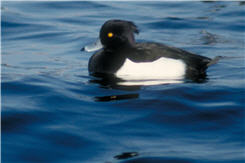 Tufted
Duck
Aythya fuligula
Tufted
Duck
Aythya fuligula
An Old World relative of the Ring-necked Ducks and scaups, the Tufted Duck is a rare annual winter visitor to the Pacific coast of North America. Few of these birds make it as far south as southern California. In San Diego County there are only three records of the Tufted Duck, the southernmost in the New World, plus three of hybrids with scaups.
Winter: San Diego County’s pure Tufted Ducks were a female in south San Diego Bay 18 February 1985 (R. E. Webster, Roberson 1993), a male at Miramar Lake 13 January–9 February 1992 (P. A. Ginsburg, Patten et al. 1995b), and a male at Famosa Slough (R8) 5 February–1 March 1998 (B. R. Zimmer, FN 52:256, 1998).
Apparent hybrid Tufted Ducks × scaups were at San Elijo Lagoon (L7) 20 February–22 March 1987 (S. Ranney‑Gallagher, King et al. 1987) and 18–24 February 1996 (E. L. Mills, NASFN 50:222, 1996) and at the San Luis Rey River mouth (H5) 16–29 February 1992 (T. Clawson, Patten et al. 1995b).
Taxonomy: The frequency of Tufted Duck × scaup hybrids suggests that some Tufted Ducks straying across the Bering Sea to Alaska mate with their closest available relatives, in lack of mates of their own kind.
 Greater
Scaup Aythya
marila
Greater
Scaup Aythya
marila
In San Diego County, near the southern tip of its winter range, the Greater Scaup is uncommon to rare. It is found with Lesser Scaups and easily overlooked among the large flocks of the more common species. The two scaups’ close similarity has led to their numbers being pooled in many studies and has left the Greater’s exact status in San Diego County poorly known.
Winter: The Greater Scaup occurs in San Diego County primarily in south San Diego Bay, where it mingles with the large flocks of the Lesser Scaup. Rarely are more than three or four individuals identified, but 35 were along the Silver Strand between Crown Cove and Coronado Cays (T9) 6 December 1988 (Macdonald et al. 1990), and 53 were in south San Diego Bay (U10) 3 March 1993 (Stadtlander and Konecny 1994). The Greater occurs at least irregularly on Mission Bay (up to 10 near Crown Point, Q8, 10 December 2000, E. Wallace) and in the San Diego River flood-control channel (R8; up to five on 12 February 2002, M. B. Mulrooney).
Elsewhere along the county’s coast the Greater Scaup is even scarcer. It has been reported on 8 of 22 Rancho Santa Fe Christmas bird counts 1980–2003 with a maximum of 35 on 18 December 1988. It has been reported on only 2 of 28 Oceanside Christmas bird counts 1976–2002, with a maximum of two on 28 December 1980. On fresh water wintering Greater Scaups have been reported only from the lower Otay River just east of San Diego Bay (V10), with one on 17 December 1977 (G. McCaskie), and Santee Lakes (P12), with two from 10 January to 2 February 1978 (J. L. Dunn) and one each on 20 January 1998 (E. Post) and 4 February 2002 (J. C. Worley).
The skeleton I previously reported (Unitt 1984) as a Greater Scaup was actually a mislabeled Lesser Scaup, but J. R. Barth found a recently dead Greater Scaup at the Chula Vista Wildlife Reserve, south San Diego Bay (U10), 13 April 2003 (SDNHM 50696).
Migration: The Greater Scaup’s typical season in San Diego County extends from 5 November (1977, one at Border Field State Park, W10, L. Bevier) to 21 March (1977, three on San Diego Bay, E. Copper). In 1978, a year of apparently exceptional abundance, the species remained as late as 19 May (four at the San Diego River mouth, AB 32:1054, 1978). Two Greater Scaups were on south San Diego Bay 30 May 1963 (AFN 17:434, 1963) and one was there 15 September 2000 (G. C. Hazard). Late stragglers are probably unhealthy; the one picked up 13 April 2003 had failed to molt properly.
One at Lake Henshaw (G17) 2 March 1985 was presumably
a spring migrant crossing from the Gulf of California to the Pacific coast (R. Higson, AB 39:349, 1985).
Conservation: There is no evidence for
historical change in the Greater Scaup’s status in
San Diego County. Though the numbers reaching San Diego may vary from
year to year, the species has never been common.
Taxonomy: Banks (1986b) ascertained that A. m. nearctica Stejneger, 1885, is the proper name for the North American subspecies of the Greater Scaup.
San Diego Bay is a major wintering site for the Lesser Scaup: about 3000–5000 converge there each year, the largest concentration in all of southern California. On south San Diego Bay, the scaup is second only to the Surf Scoter as the most abundant bird. Mission Bay has become important too, with about 1000 wintering scaups. Other coastal wetlands have relatively few, but some inland lakes host flocks of dozens. An occasional Lesser Scaup straggles through the summer, but the species is not known to nest south of San Francisco Bay.
Winter: Regular thorough surveys of San Diego Bay 1988–89 (Macdonald et al. 1990) and 1993–94 (Manning 1995, Mock et al. 1994, Stadtlander and Konecny 1994) are the soundest basis for estimating the Lesser Scaup’s numbers. Macdonald et al. (1990) and Manning (1995) both found about 2000 in south San Diego Bay outside the salt works. Within and near the salt works, Stadtlander and Konecny (1994) found a maximum of 4409 in February 1993. Preston and Mock (1995) found up to 867 in central San Diego Bay 25 January 1994, and Mock et al. (1994) found up to 301 in the north bay (northwest of the bridge) 12 January 1993. From 1997 to 2001 our less systematic counts ranged up to 3100 on south San Diego Bay (U10) 18 December 1999 (J. L. Coatsworth), suggesting that similar numbers continue, at least in some years.
In Mission Bay our counts ranged up to 1170 in the northeast quadrant of the
bay (Q8) 26 January 1999, 1016 there 16 January 2000 (J. C. Worley), and 300 in
the southeast corner 24 December 1997 (P. Unitt).
Along the coast away from San Diego and Mission bays the Lesser Scaup is widespread but far less abundant. At the other coastal wetlands the scaup’s greatest concentrations are at the Santa Margarita River mouth (G4; up to 150 on 8 February 2000, P. A. Ginsburg), San Elijo Lagoon (L7; during the atlas period, up to 50 on 14 January 2000, A. Mauro), and the San Dieguito River mouth (M7; up to 150 on 26 December 1999, M. Baumgartel).
Inland, the Lesser Scaup occurs in small numbers on most lakes, in large numbers on a few. For no clear reason, particularly large numbers of scaup frequent Dixon Lake (I11; up to 190 on 3 January 1998 (J. Russell), Lake Ramona (L12; up to 88 on 25 January 1998, M. and B. McIntosh), Lake Miramar (N10; up to 200 on 3 January 1998, P. Unitt), and Santee Lakes (P12; up to 56 on 5 December 1997, E. Post).
The Lesser Scaup is a rare visitor to the Borrego Valley, recorded on 6 of 19 Anza–Borrego Christmas bird counts 1984–2002. All records for this area are of three or fewer, except for 13 at Ram’s Hill (H25) 20 December 1998 (R. Halford).
Migration: In some years Lesser Scaups begin arriving in early October (Unitt 1984, King et al. 1987), but surveys of San Diego Bay suggest that in others they do not arrive until mid November. Their abundance peaks in January and February. Most Lesser Scaups depart in mid March, but some remain to mid April (20 in the San Diego River flood-control channel, R8, 15 April 1999, J. R. Barth) and a few to mid or late May (three at Buena Vista Lagoon, H5, 11 May 1999, M. Freda; four at Dixon Lake 17 May 1999, A. G. and D. Stanton; one west of Ramona, K13, 26 May 2000, P. M. von Hendy).
Birds grounded at Vallecito (M25) in early April 1966 and at Angelina Spring (I22) 3 April 1966 (Banks 1967) suggest that the Lesser Scaup, like the Brant and Surf Scoter, uses eastern San Diego County as an overland migration corridor. But no parallel occurrences have come to light since.
A few Lesser Scaups fail to migrate and remain to summer both along the coast and inland. From 1997 to 2001 we noted three such stragglers, at Lake Cuyamaca (M20) 20 June–8 July 1998 (A. P. and T. E. Keenan), at Barrett Lake (S18) 22 June 1997 (J. Hannan), and on south San Diego Bay 11 August 2000 (G. Grantham).
Conservation: The number of the Lesser Scaup on San Diego Bay, though difficult to monitor, is one of the primary gauges of the bay’s biological viability. Because intensive surveys have followed the same procedure for only a single year, the San Diego Christmas bird count is the only basis for assessing long-term changes. This count is inconsistent because of variation in coverage, the variable availability of a boat, and, possibly, temporal variation in the birds’ arrival. The scaup’s abundance does not reach its peak until January, though the count has long been scheduled for the third Saturday of December. Numbers have been higher in some past years, up to about 11,800 on 3 January 1965 and 15 December 1979. They have not exceeded 4000 since 1984. So a decline seems likely, but better monitoring is called for. Just a single-day survey by boat about 1 February would be adequate, if coordinated with coverage of the salt works.
Factors that could affect the scaup include water pollution, chemical contamination of their foods, disturbance by boats, and bayshore development. Among 14 species of water birds studied in San Diego Bay, the scaup avoids developed shorelines the most strongly (J. A. Manning).
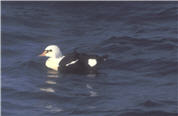 King
Eider
Somateria spectabilis
King
Eider
Somateria spectabilis
Eiders are birds of the far north, rarely reaching even northern California as winter vagrants. The single record of the King Eider for San Diego County is the species’ southernmost along the Pacific coast of North America.
Winter: San Diego County’s King Eider was an adult male, found at the Imperial Beach pier (V10) 4 December 1982. It later moved up the Silver Strand to Glorietta Bay (T9), where it remained to 25 January 1983 (M. B. Stowe, Morlan 1985). Seven King Eiders, more than in any year before or since, reached southern California during the winter of 1982–83, a year of El Niño.
Harlequin Duck Histrionicus histrionicus
More typical of rocky coasts farther north, the Harlequin Duck is only a casual visitor to San Diego County. Here, in atypical habitats at the southern extreme of its winter range, the Harlequin Duck does not do well—several of the birds have failed to return north on their proper schedule. Our five-year atlas period, 1997–2002, saw a spate of Harlequin Ducks, 6 of the 12 recorded in San Diego County.
Winter: During the atlas period, Harlequin Ducks were found at Agua Hedionda Lagoon (I6) 16 February–14 March 2001 (E. Wade, NAB 55:227, 2001), Torrey Pines State Reserve (N7) 26 December 1999 (S. Walens), La Jolla (P7) 20 February 1998 (G. McCaskie, FN 52:257, 1998), De Anza Cove, Mission Bay (Q8), 4–18 March 2001 and 28 October 2001–27 February 2002 (D. G. Seay, NAB 55:227, 2001; 56:106, 223, 2002), the power plant in Chula Vista on San Diego Bay (U10) 22 January–26 May 1998, Chula Vista, R. T. Patton, FN 52:257, 503, 1998), and the Imperial Beach pier (V10) 7 November 1999–17 May 2000 (G. Moreland, T. Stands, NAB 54:104, 220, 326, 2000). One in the San Diego River flood-control channel (R8) 18–30 December 2001 (R. E. Webster) was presumably the same bird spending most of its time at De Anza Cove. Unitt (1984) listed earlier records, three from San Diego Bay and one from Agua Hedionda Lagoon, except for one on the Rancho Santa Fe Christmas bird count 26 December 1982. The records for San Diego County were the southernmost for the Pacific coast until the first for Baja California in 2003 (NAB 57:407, 1983).
Migration: The Harlequin Duck’s return to De Anza Cove 28 October 2001 is the species’ earliest arrival in San Diego County. One on San Diego Bay 5 October 1983 had more likely summered (AB 38:246, 1984). The latter bird included, 4 of the county’s 12 Harlequin Ducks have overstayed their expected departure time in March. One found at Agua Hedionda Lagoon 31 December 1977 remained there continuously for over five years until last reported 28 February 1983 (AB 27:338, 1983).
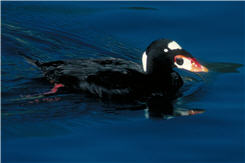 Surf
Scoter
Melanitta perspicillata
Surf
Scoter
Melanitta perspicillata
San Diego Bay supports probably the largest concentration of Surf Scoters in the species’ entire winter range: 8000 to 10,000 birds in the mid 1990s. It remains one of the scoter’s key winter habitats in spite of numbers in the 1990s being no more than a third of what they were in the 1960s. Because of its dependence on mollusks as food and its sensitivity to disturbance by boats, the Surf Scoter is the most critical indicator of the biological health of San Diego Bay. San Diego County plays another major role in the Surf Scoter’s life cycle by being the route through which birds wintering in the Gulf of California cross overland to the Pacific Ocean.
Winter: The Surf Scoter is the most abundant bird on San Diego Bay. The birds have a preference for water 5 to 35 feet deep and are concentrated largely from the Naval Amphibious Base south (Preston and Mock 1995). Because they feed largely on mollusks, especially mussels, they concentrate where these animals colonize. Rocky ocean bottom and the pilings for piers are habitats secondary to the bed of San Diego Bay.
The systematic surveys of the bay from 1993 to 1995 give us the most current picture of the species’ status in this critical habitat. In the north bay, from the entrance to the bridge, in weekly surveys through 1993, Mock et al. (1994) found a maximum of 757 on 19 January. In the central bay, from the bridge to Crown Cove and the Sweetwater River, in monthly surveys through 1993 and weekly surveys through 1994, Preston and Mock (1995) found yearly maxima of 6583 on 20 January 1993, 5708 on 8 March 1994, and 8945 on 28 December 1994. In the central and south bay combined, in weekly surveys from April 1993 to April 1994, Manning (1995) found a maximum of 7458 on 28 December 1993. The combination of these results suggests the figure of 8000–10,000 for San Diego Bay’s total winter population in the 1990s. Counts during the atlas period from 1997 to 2002 were largely from shore and not systematic. But numbers of up to 5000 on San Diego Bay near the Chula Vista Nature Center (U10) 15–21 December 1997 (B. C. Moore) and 3500 by boat on San Diego Bay 15 December 2001 (M. Bache) suggest the scoters sustained something close to that level to the beginning of the 21st century.
In Mission Bay Surf Scoters are generally absent. But hundreds congregate on the ocean just off shore, especially off Imperial Beach and the Tijuana River estuary (V10/W10; up to 782 on 19 December 1998, R. B. Riggan) and Point Loma (S7; up to 415 on 18 December 1999, J. C. Worley). Elsewhere along the coast Surf Scoter numbers are highly variable. Results of Oceanside Christmas bird counts range from 1040 in 1987 to 10 in 2001 and 2002. Those of Rancho Santa Fe counts range from 1026 in 1986 to two in 2001.
Except for the outer basin of Agua Hedionda (I6), Surf Scoters avoid the lagoons of northern San Diego County. As a result of the deepening of Batiquitos Lagoon, ordered as mitigation for loss of subtidal habitat in the Los Angeles harbor, the scoter visited that lagoon in small numbers, occasionally reaching the east basin (J7; up to eight on 15 February 1998, R. Campbell).
The Surf Scoter uses inland lakes as a migration stopover only, not as normal winter habitat. But nine on El Capitan Reservoir (O16) 20 December 1998 (S. Kingswood) were outside the main migration periods.
Migration: Fall arrival of Surf Scoters ranges from mid October to early November. In their weekly surveys of central San Diego Bay in 1994, Preston and Mock (1995) found no scoters summering, then two on 11 October and 131 on 19 October. But parallel surveys of the north bay in 1993 yielded no increase over summer numbers until 26 October with six, and 2 November with 17. Fall migration continues into early December: over 1000 were streaming south over the ocean at La Jolla (P7) 6 December 1998 (G. McCaskie). Numbers on San Diego Bay peak from mid December to early March.
Spring departure takes place mainly from March to mid April. No date can
be given for final departure because small numbers remain through summer, at
least in some years. In their studies of north and central San Diego Bay,
Mock et al. (1994) and Preston and Mock (1995) found up to six on 6 June
1993. Atlas observers found up to 31 at Los Peñasquitos
Lagoon (N7) 6 June 1998 (D. R. Grine), 30 along the
Silver Strand 25 August 1998 (B. C. Moore), and 25 in south San Diego Bay 19
June 1998 (Y. Ikegaya). Earlier counts of
summering birds ran as high as 85 (Unitt 1984).
The most interesting aspect of Surf Scoter migration is its use of San Diego County as a corridor for crossing between the Gulf of California and Pacific coast. Many of the birds make the trip nonstop, but storms may compel them to stop on lakes or, rarely, crash on land. The principal route parallels county Highway S2, the historic route of least resistance over the mountains for man and bird alike. Because Lake Henshaw (G17) lies just beyond the pass at the head of San Felipe Valley (H20), most records and the largest numbers have been on that lake, up to 1000 from 16 to 18 March 1983 (R. Higson, AB 37:912, 1983), over 1000 on 21 March 1992, and 900 on 23 March 1997 (G. McCaskie, AB 46:480, 1992; FN 51:927, 1997). Records elsewhere along the route are too numerous to list, but notable during the atlas period were two on a small pond in San Felipe Valley (H20) 22 March 1998 and 17 April 1999 (A. P. and T. E. Keenan). The passage is not restricted to this narrow corridor, however. With the establishment of ponds the Surf Scoter has begun to stop occasionally at Borrego Springs (G24; up to two on 30 March 1998, P. D. Jorgensen), and other records are scattered south to Jacumba (U28; Sams and Stott 1959, one on 4 April 1999, P. Unitt).
Extreme dates for spring migrants inland are 21 January (2001, one at Borrego Springs, P. D. Jorgensen), the only record for January, and 12 May (1995, 60 on Lake Henshaw, G. McCaskie, NASFN 49:309, 1995). In 1983, when storms associated with El Niño brought many Surf Scoters down on Lake Henshaw, Roger Higson monitored the lake regularly, noting the species from 4 March to 1 May. The Surf Scoter’s use of this route in fall is less clear than in spring, perhaps because the rarity of storms at this season means the birds are seldom obliged to stop. Nevertheless there are five fall records on dates from 12 November (1985, 238 on Lake Henshaw, R. Higson, AB 40:158, 1986) to 6 December (1986, one on Lake Cuyamaca, C. G. Edwards, AB 41:328, 1987)
Conservation: Because of its diet of mollusks, which concentrate contaminants in the water, the Surf Scoter is vulnerable to pollution and a possible indicator of water quality. Like other diving seabirds, it is highly susceptible to oil spills. Yet in spite of water quality in San Diego Bay improving since the 1960s, Surf Scoter numbers have declined over the same period. Guy McCaskie attempted to census scoters on San Diego Bay in the 1960s, and the results are reflected in totals of Christmas bird counts: an average from 1962 to 1967 of 24,084 and a maximum of 30,097 in 1962. Subsequent counts have not sampled scoters consistently, but the results of the surveys in the 1990s show that the numbers had dropped to about one third of the former figure. Two of the count’s four lowest totals since the 1950s fell within the five-year atlas period, 1997–2002. The decrease may not be restricted to San Diego Bay alone. In spite of huge annual variation, totals on the Oceanside and Rancho Santa Fe counts, which represent scoters on the ocean, both reached their lowest ever in 2001. Taken together, all three species of scoter are on the decline in their breeding range in Alaska (Hodges et al. 1996).
One negative factor on San Diego Bay is disturbance by boats, which Macdonald et al. (1990) proposed as the primary reason for the scoter’s decline. Preston and Mock (1995) found the scoter to be the water bird most sensitive to such disturbance, fleeing a boat at a distance greater than other species and concentrating in regions of central San Diego Bay with less boat traffic.
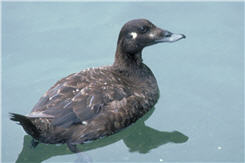 White-winged
Scoter
Melanitta fusca
White-winged
Scoter
Melanitta fusca
The White-winged Scoter was once a common winter visitor to San Diego County, especially to San Diego Bay. Its almost complete disappearance since the 1970s, in lack of reports of a catastrophic decline in the species as a whole, suggests that the winter range has shifted north, few individuals bothering to migrate this far south.
Winter: From 1997 to 2002 we noted the White-winged Scoter only 13 times in San Diego County. Only three sightings were of more than a single individual: eight at La Jolla (P7) 21 January 1999 (L. and M. Polinsky), three in the west basin of Batiquitos Lagoon (J6) 6 February 1998 (C. C. Gorman), and 20 at San Onofre (C1) 27 February 1999 (L. Ellis). At least the last, and possibly all three records, were of spring migrants rather than wintering birds. Surprisingly, only four of the birds were within San Diego Bay, the traditional site for the species. More intensive surveys of the bay in the 1990s also yielded few White-winged Scoters. In spite of weekly or monthly surveys of north and central San Diego Bay 1993–95, Mock et al. (1994) and Preston and Mock (1995) found only a single individual in the north bay 4 April 1995. On the basis of weekly surveys of the central and south bay 1993–94, Manning (1995) recorded a cumulative total of 13 in the south bay, which could have included repeated sightings of the same individual(s).
Migration: The White-winged Scoter’s migration schedule is similar to that of the Surf Scoter, with fall arrival beginning in late October (18 October 1969, three on San Diego Bay, J. L. Dunn; 28 October 2000, one on the south bay, E. Wallace) and spring departure completed in early April. Since 1970, two summer stragglers have been recorded on San Diego Bay, near the Naval Amphibious Base (T9) 30 June 1988 (Macdonald et al. 1990) and one near the D Street fill (T10) 9 June 1999 (R. T. Patton).
In spite of being a regular if rare migrant at the Salton Sea (Patten et al. 2003), the White-winged Scoter does not use the migration corridor across San Diego County as does the Surf Scoter. There is only a single inland record, of one at Lake Henshaw (G17) 2 April 1982 (R. Higson, AB 36: 893, 1982).
Conservation: The White-winged Scoter was apparently always irregular in abundance in San Diego County, but over the long term its history has been one of sharp decline. Stephens (1919a) called the White-winged Scoter a “common winter resident,” and Sefton (1939) reported about 500 on San Diego Bay 11 November 1938, saying this was the largest concentration he had seen. Decline had apparently begun by the 1950s, as Sams and Stott (1959) called the species “regular but moderately sparse.” From the inception of regular San Diego Christmas bird counts in 1953, the White-winged Scoter was recorded annually through 1971. From 1955 through 1971 totals ranged from 5 to 200, except for 2000 on 3 January 1960. The last winter with any substantial influx was 1979–80, when the San Diego Christmas bird count yielded 170. Since 1981 the count has not exceeded four, and from 1987 through 2002, the species was recorded on only 6 of 16 counts. The White-winged Scoter has not appeared on an Oceanside Christmas bird count since 1987 or on a Rancho Santa Fe count since 1988.
Though local factors like water pollution, disturbance by boats, and contamination of the mollusks on which the feed could all have affected the White-winged Scoter on San Diego Bay, unknown larger-scale factors are probably more important. The numbers of scoters (all species combined) breeding in Alaska declined through the latter half of the 20th century, but not to the degree the White-winged Scoter has declined in San Diego. The southern edge of the White-winged’s breeding range on the northern Great Plains has retracted northward (Brown and Frederickson 1997), and some of the birds originating in this region migrate to California (Houston and Brown 1983). Climatic warming could result in the scoter’s failing to migrate as far south as formerly.
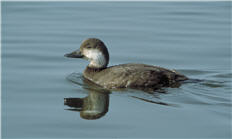 Black
Scoter
Melanitta nigra
Black
Scoter
Melanitta nigra
The Black is the scarcest of the three scoters in San Diego County, reaching the county as a winter visitor at a rate of about one per year. Like those of the White-winged and Surf Scoters, its numbers have declined, but unlike the others, it was never common. Like the other scoters, it occurs usually on San Diego Bay or on the ocean near shore, especially near piers, where it can feed on mussels.
Winter: Only six Black Scoters were found in San Diego County during the five-year atlas period, 1997–2002. Their distribution appears representative. Only one was on San Diego Bay, near the J Street marina, Chula Vista (U10) 21 February–2 March 2002 (M. B. Mulrooney). Other sites were the Oceanside pier (H5; 16 November 1997, C. Jones), the ocean off Oceanside (26 December 1998, D. W. Povey), the Imperial Beach pier (V10; 8 November 1999, B. Foster, NAB 54:104, 2000), the Tijuana River estuary (V10; 20 December 1997–1 January 1998, W. Mittendorff, FN 52:257, 1998), and Border Field State Park (W10; 18 December 1999, S. Walens).
Migration: Dates for the Black Scoter in San Diego County range from 31 October (1984, AB 39:102, 1985) to 18 April (1928, Helmuth 1939), except for the two credible records of summer stragglers: two on San Diego Bay 21 June–24 July 1962 (AFN 16:507, 1962) and one there June–July 1985 (G. McCaskie, AB 39:962, 1985). The only inland record for the county is of a spring migrant at Lake Henshaw (G17) 18 March 1983 (R. Higson, AB 37:912, 1983).
Conservation: Although the Black Scoter was recorded only once in San Diego County before 1950 (Helmuth 1939), it was reported on nine consecutive San Diego Christmas bird counts, 1954–62, with an average of 6.2 and a maximum of 17 on 26 December 1954. Even if some of these birds were misidentified Surf Scoters, the numbers suggest the Black was considerably more frequent in the 1950s and 60s than at the beginning of the 21st century. The decline has been essentially continuous. In the 20 years from 1963 to 1982 the San Diego Christmas bird count averaged 1.15 Black Scoters per year, whereas in the 20 from 1983 to 2002 it averaged 0.25 per year.
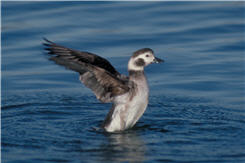 Long-tailed
Duck
or Oldsquaw Clangula
hyemalis
Long-tailed
Duck
or Oldsquaw Clangula
hyemalis
The Long-tailed Duck is rare but of nearly annual occurrence on San Diego Bay, which represents the southern tip of the species’ winter range. In good years up to seven individuals have been found, but in others there have been none at all. The Long-tailed Duck is less frequent in Mission Bay and only casual elsewhere in San Diego County.
Winter: San Diego Bay is the primary site for the Long-tailed Duck in San Diego County, though it is irregular even there. From 1997 to 2002 its numbers varied from at least seven in 1998–99 to zero in 2000–01, the only one of the five years of the atlas period in which it was missed. It has been recorded on 18 of 45 San Diego Christmas bird counts 1958–2002. Systematic surveys of San Diego Bay 1993–95 found the species occasionally in all parts of the bay, with no concentration in the south bay, as for so many other ducks. These studies yielded no more than two individuals per day (Manning 1995, Mock et al. 1994, Stadtlander and Konecny 1994). From 1997 to 2002 the largest numbers were five in north San Diego Bay at Harbor Island (S8) 4 February 1999 (E. C. Hall) and six, probably the same individuals, at the submarine base on the east side of Point Loma (S7) 17 April 1999 (P. A. Ginsburg). No larger numbers had been reported previously.
Though the Long-tailed Duck occurs occasionally in Mission Bay, during the atlas period we found only one there, in the bay’s northeast quadrant (Q8) 7 January 1999 (E. Wallace). There have been a few sightings in the Tijuana River estuary and at the Imperial Beach pier (V10), including one at the pier 18 December 1999 (G. McCaskie). Along the coast from La Jolla to Oceanside the species is reported only about once every three or four years and was missed entirely during the atlas period. Inland there are only two records, of one at Santee Lakes (O12/P12) 6–8 November 1991 (C. G. Edwards, AB 46:148, 1992) and one at Lake Murray (Q11) 10 January–28 February 1999 (J. Morris, N. Osborn, NAB 53:208, 1999).
Migration: The Long-tailed Duck begins arriving in November, with an earliest date of 1 November (1979, one at Oceanside, AB 34:200, 1980; 1990, one at Point Loma, R. E. Webster, AB 45:151, 1991). Most individuals depart in March; those at the submarine base in 1999 were unusually late (three remaining on 22 April, one on 9 May, P. A. Ginsburg). There are 10 records of later stragglers, in poor plumage from failure to molt, including one that summered in south San Diego Bay (U10) in 1998 (R. T. Patton, FN 52:503, 1998).
Conservation: At the source, in Alaska, the Long-tailed Duck population is in decline. Aerial surveys of the arctic coastal plain found numbers decreasing at an average rate of 2.5% per year from 1986 through 2002 (Mallek et al. 2003), and the decrease over the period 1977–94 was even sharper (Hodges et al. 1996). But San Diego has received its dribble at the same rate for at least 40 years and probably longer—Stephens (1919a) called the species an “occasional winter visitant.”
About 2000 Buffleheads winter on San Diego Bay, making the species the third most abundant diving duck on the bay, behind the Surf Scoter and Lesser Scaup. The Bufflehead is a common winter visitor in other coastal estuaries also. It is widespread on lakes and ponds inland but common on just a few of these. Stragglers remaining through the summer are only occasional.
Winter: South San Diego Bay is the center for the Bufflehead in San Diego County, as for so many other ducks. Weekly counts of the salt works and adjacent bay from February 1993 through February 1994 disclosed a maximum of 976 on 3 March 1993 and a steady level of about 300 through the winter of 1993–94 (Stadtlander and Konecny 1994). These numbers remained fairly consistent through the beginning of the 21st century: the San Diego Christmas bird count 15 December 2001 yielded 478 within the salt works (D. C. Seals) and 397 just outside them in southwestern San Diego Bay (P. R. Pryde). The Bufflehead is also common elsewhere in the bay: systematic counts 1993–95 recorded up to 375 in the north bay 21 December 1993 and 480 in the central bay 3 January 1994 (Mock et al. 1994, Preston and Mock 1995). Substantial numbers of Buffleheads winter also in Mission Bay, with up to 150 in the bay’s northwest quadrant (Q7) 8 January 2000 (L. Polinsky) and 133 in the northeast quadrant (Q8) 16 January 2000 (J. C. Worley).
The Bufflehead uses all other substantial coastal wetlands as well, being most numerous in Batiquitos Lagoon (J6/J7; up to 120 on 22 December 2001, R. and A. Campbell) and the San Dieguito River estuary (M7; up to 114 on 16 December 1997, D. R. Grine). The most consistent inland sites are Dixon Lake (I11; up to 40 on 6 January 2001, L. Hunter), sewage ponds in San Vicente Valley at the base of Spangler Peak (L15; up to 60 on 2 February 2001, A. Mauro), and the upper ponds of Santee Lakes (O12; up to 53 on 18 February 2001, R. Breisch). Smaller numbers are regular elsewhere on the coastal slope, including the higher mountains and the Campo Plateau. On ponds in the Borrego Valley the Bufflehead is rare. Most records there are of just one or two individuals and none is of over five, as at the Roadrunner Club (F24) 15 December 1987 (A. G. Morley) and at Club Circle (G24) 5 December 1998 (P. D. Ache).
Migration: Buffleheads arrive occasionally in late October (four in the San Diego River flood-control channel, R8, 22 October 1985, D. Patla; two there 25 October 1981, P. Unitt). But weekly surveys of San Diego Bay 1993–95 did not have any before 2 November (Mock et al. 1994, Preston and Mock 1995). Manning’s (1995) weekly surveys of San Diego Bay found the Bufflehead’s numbers there steady from December through March. Departure is largely in April. Late stragglers were four in Batiquitos Lagoon (J7) 4 May 2001 (C. C. Gorman) and two in central San Diego Bay 9 May 1994 (Preston and Mock 1995).
Summer stragglers average less than one per year in San Diego County. During the atlas period there were three, near Ramona (K13) 26 May 2000 (P. M. von Hendy), at Big Laguna Lake (O23) 2 June 2001 (C. G. Edwards), and along the lower Sweetwater River (T11) 2 July 1998 (P. Famolaro).
Conservation: In contrast to the decreases evident in the Surf Scoter and Common Goldeneye, the Bufflehead appears to have maintained its numbers through the second half of the 20th century. Christmas bird counts suggest much annual variation but no consistent trend.
 Common
Goldeneye Bucephala
clangula
Common
Goldeneye Bucephala
clangula
The Common Goldeneye is far from common in San Diego County. It is an uncommon winter visitor only in the salt works of south San Diego Bay and rare elsewhere. The species is on decline in San Diego Bay, probably more because of a shift in the species’ winter distribution than because of a decline in total numbers.
Winter: The south end of San Diego Bay is the only current regular site for the Common Goldeneye in San Diego County. From 1997 to 2002 numbers here ranged up to only eight individuals, except for 13 on 16 February 2001 (G. Grantham). Weekly surveys of the salt works from February 1993 to February 1994 yielded a maximum of 17 in February 1994 and monthly averages of no more than eight (Stadtlander and Konecny 1994). Surveys of south San Diego Bay outside the salt works 1988–89 revealed no more than five per day. Other regular studies throughout San Diego Bay outside the salt works 1993–95 did not find any (Manning 1995, Mock et al. 1994, Preston and Mock 1995).
Elsewhere along the coast of San Diego County the goldeneye is seldom seen. During the atlas period only about 10 individuals showed up along the coast away from south San Diego Bay. All sightings were of single individuals, except for two in the east basin of Buena Vista Lagoon (H6) 23 December 1998 and up to three in the Santa Margarita River estuary (G4) 27 January 1999 (P. A. Ginsburg). Inland, the species is even scarcer but shows up occasionally on small ponds as well as larger lakes. Inland sightings during the atlas period were of one at 3.3 miles southeast of central Escondido (J11) 29 December 2001 (P. Hernandez), two in Boden Canyon (J14) 18 January 1999 (R. L. Barber), one at the east end of Lake Hodges (K11) 27 December 1998 (O. Carter), four on Sweetwater Reservoir (S12) 17 January 2002 (G. Chaniot), one on Upper Otay Lake (T13) 14 February 1999 (J. R. Barth), and one on Lake Domingo (U26) 13 January 2000 (F. L. Unmack). In the Anza–Borrego the only record is of three on a golf-course pond at Club Circle, Borrego Springs (G24), 23 December 1967 (ABDSP database).
Migration: Dates for the Common Goldeneye in San Diego County extend from “October” 1919
(Mission Bay, SDNHM 2168) and 9 November (1962, three on San Diego Bay, AFN
17:67, 1963) to 21 March 1999 (one in the Santa Margarita River estuary, P. A. Ginsburg)
and 7 April 2000 (eight in the salt works, R. T. Patton), except for the three
summer stragglers listed by Unitt (1984).
Conservation: Numbers of Common Goldeneyes in San Diego County have declined almost continuously since the early 1960s. The peak on the San Diego Christmas bird count was 94 on 31 December 1961. From 1963 to 1982 the count averaged 19.1 goldeneyes, from 1983 to 1992 it averaged 13.1, and from 1993 to 2002 it averaged only 3.5.
Eadie et al. (1995) reported that the Common Goldeneye’s population, taken as a whole, was approximately
stable through the late 20th century. Therefore, it seems
likely that the birds have simply shifted, perhaps not needing to migrate as
far south as San Diego as the climate warms. Also, since the 1980s,
Common Goldeneyes have begun wintering in large
numbers on the Colorado River below Glen Canyon Dam (Rosenberg et al. 1991, LaRue et al. 2001). These birds presumably abandoned
other sites where they had wintered previously.
Taxonomy: The Common Goldeneye is usually divided into an Old World and a New World subspecies; B. c. americana (Bonaparte, 1838) is the one in North America.
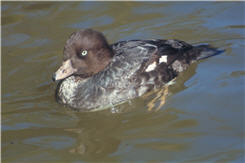 Barrow’s
Goldeneye Bucephala
islandica
Barrow’s
Goldeneye Bucephala
islandica
The
four records of Barrow’s Goldeneye in San Diego
County are the species’ southernmost on the Pacific coast. The bird is
unknown in Mexico, though it has become regular in small numbers below the
large dams on the Colorado River above Parker.
Winter: One Barrow’s Goldeneye was at Otay (V11) 7 March 1964 (McCaskie and Banks 1966), one was in San Diego Bay along the Silver Strand (T9) 15–20 February 1975 (AB 29:741, 1975), one was at the south end of San Diego Bay (V10) 7 January 1979, and possibly the same individual was at this locality again 9 March 1979 (AB 33:312, 1979).
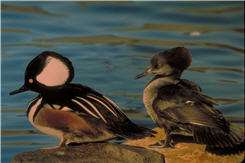 Hooded
Merganser
Lophodytes cucullatus
Hooded
Merganser
Lophodytes cucullatus
Finding the ornate and striking adult male Hooded Merganser in San Diego County is an uncommon delight. Males and females combined, only 30 to 40 Hooded Mergansers are noted countywide each year. Though it occurs occasionally on larger lakes and coastal wetlands, this winter visitor prefers small freshwater ponds.
Winter: The Hooded Merganser is widely scattered through San Diego County, but it has a few favored sites: a private business park along San Marcos Creek at Questhaven Road (J8; up to 14 on 27 January 1998, J. O. Zimmer), Santee Lakes (O12/P12; up to 12 on 19 January 2000, G. Chaniot), and a pond in La Posta Creek 1 mile northeast of La Posta Ranch (S24; six on 9 December 1998 and 23 January 2000, L. J. Hargrove).
Though the Hooded Merganser avoids San Diego Bay and occurs in most other coastal wetlands only rarely, it is regular in the flood-control channel at the mouth of the San Diego River and in adjacent Famosa Slough (R8), where numbers ranged up to three on 22 January 2001 (P. R. Pryde). With records from Palomar Mountain (D14; three from 31 December 1999 to 9 February 2000, P. D. Jorgensen) and Lake Cuyamaca (M20; one on 7 December 2001, R. Ronin), the Hooded Merganser is as likely to occur in the higher mountains as at most places along the coast. In the Anza–Borrego Desert there are just four records of single individuals, all from ponds in the Borrego Valley.
Migration: From 1997 to 2002 dates for the Hooded Merganser in San Diego County ranged from 3 November (1999, one at Borrego Springs, F24, R. Thériault) to 24 March (2000, two at the San Diego River mouth, R7, M. Billings). Extreme dates ever recorded are apparently still the same reported by Unitt (1984), 25 October and 30 March, except for a straggler at Santee Lakes 28 May 1977 (AB 31:1041, 1977).
Conservation: The Hooded Merganser has never been common in San Diego County. Christmas bird counts suggest the number reaching this area stayed at about the same low level for decades. An increase, however, may have started about the time the atlas study was initiated in 1997. The Rancho Santa Fe Christmas bird count, for example, averaged only 0.6 Hooded Mergansers from 1980 to 1996. But from 1997 to 2003 it averaged 6.2. The Escondido count, though initiated in January 1986, did not record the Hooded Merganser until 2000, yet in 2002 it yielded 10. The Hooded Merganser, with its preference for small lakes, is a logical beneficiary of the importation of water and installation of reservoirs.
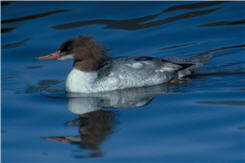 Common
Merganser
Mergus merganser
Common
Merganser
Mergus merganser
The Common Merganser’s distribution in San Diego County is the converse of the Red-breasted’s. Both are winter visitors, but the Common frequents inland lakes and only rarely visits coastal wetlands. It prefers lakes in the foothills and mountains over those in the coastal lowland.
Winter: The lakes on which the Common Merganser winters in greatest numbers are Wohlford (H12/I12; up to 160 on 29 December 2001, N. Osborn), Cuyamaca (M20; up to 42 on 18 February 1999, A. P. and T. E. Keenan), and Henshaw (G17). At the last, our highest count from 1997 to 2002 was of 60 on 29 February 2000 (J. L. Coatsworth). The median on Lake Henshaw Christmas bird counts 1981–2002 was 18, but large flocks are occasional. The count on 23 December 1996 yielded an exceptional 800. Smaller numbers are regular on El Capitan (N16/O16; up to 12 on 6 February 2001, D. C. Seals, 16 January 2002, J. R. Barth) and Morena (T21/S21/S22; up to 12 on 16 February 1998, S. E. Smith) and less frequent on other foothill and mountain lakes. Even minor ponds in the mountains get the occasional flock of Common Mergansers, such as 10 at Wynola (J19) 17 January 1999 (S. E. Smith) and 10 at the Lucky 5 Ranch, Laguna Mountains (N21/N22), 12 January 2002 (G. L. Rogers).
In the coastal lowland away from the steeper hills the Common Merganser is rare. During the atlas period we noted only a few scattered individuals in this zone. In coastal wetlands the species is even scarcer, with just four sightings 1997–2002 and only one of more than a single bird (three in the Tijuana River estuary, V10, 19 January 1998, R. B. Riggan). The various systematic surveys of San Diego Bay yielded only five in the intake channel for the power plant at Chula Vista (U10) 7 February 1989 (Macdonald et al. 1990) and single birds near the south end of the Silver Strand (U10) 29 December 1993 and 5 January 1994 (Stadtlander and Konecny 1994).
Records for the Anza–Borrego Desert are all from ponds in Borrego Springs (F24/G24): three or four from 3 to 31 March 1991, one on 18 December 1992 (A. G. Morley), and one from 11 December 1999 to 18 February 2000 (M. L. Gabel)
Migration: The Common Merganser occurs in San Diego County primarily from 12 November (1978, 10 at Lake Henshaw, D. W. Povey) to March. One at Lake Cuyamaca 14 April 2001 (M. Billings) and two at Lake Morena 26 April 1998 (S. E. Smith) were exceptionally late. The only summer straggler recorded was one at Lower Otay Lake (U13/U14) 15 June–26 September 1983 (R. E. Webster, D. W. Povey, AB 37:1027, 1983; 38:246, 1984).
Conservation: The variation from year to year on Escondido (including Lake Wohlford) and Lake Henshaw Christmas bird counts is so great that any trend in Common Merganser numbers through the 1980s and 1990s is unclear. The flock on Lake Wohlford, however, was no more than 75 from 1986 to 2000 but reached 160 in 2001 and 101 in 2002. In any case, before the building of dams and the stocking of reservoirs with fish the Common Merganser would have found practically no habitat in San Diego County.
Taxonomy: The New World subspecies of the Common Merganser is M. m. americanus Cassin, 1852.
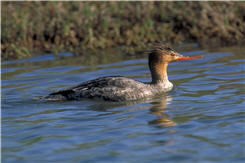 Red-breasted
Merganser
Mergus serrator
Red-breasted
Merganser
Mergus serrator
Of California’s three mergansers, the Red-breasted is the only one with a preference for salt water. The Red-breasted Merganser is a common winter visitor on San Diego Bay but much scarcer at other coastal wetlands and rare on inland lakes. Almost all Red-breasted Mergansers reaching San Diego County are females or immatures with white breasts and rusty heads.
Winter: San Diego Bay is by far the principal site for the Red-breasted Merganser in San Diego County. In weekly surveys of the central and south bay from April 1993 to April 1994 Manning (1995) recorded an average of about 70 in January, the peak month, and a maximum of 117 on 21 January 1994. In weekly surveys of the salt works and adjacent south bay from February 1993 to February 1994 Stadtlander and Konecny (1994) recorded an average of about 100 in December, the peak month in that study, and a maximum of 184 on 29 December 1993. From 1997 to 2002 the maximum reported in a single atlas square was 45 in southwestern San Diego Bay (U10) 18 December 1998 (P. R. Pryde). Numbers in the central and north bay are smaller than in the south bay. In weekly surveys of the central bay (National City to bridge) Preston and Mock (1995) found a maximum of 32 on 20 December 1994, whereas in weekly surveys of the north bay (bridge to mouth) Mock et al. (1994) found a maximum of 44 on 10 February 1993 and 7 December 1994.
Elsewhere along the coast the merganser is less numerous and less consistent but occurs both within estuaries and on the ocean near shore. Numbers as high as 30 along the beach at Encinitas (K6) 1 January 1999 (J. Ciarletta) and 18 in the west basin of Batiquitos Lagoon (J6) 28 December 1999 (R. and A. Campbell) are unusual. From 1976 to 2002 the Oceanside Christmas bird count averaged 9.1 Red-breasted Mergansers; from 1980 to 2003 the Rancho Santa Fe count averaged 8.8.
Though the Red-breasted is by far the commonest merganser along the coast, in San Diego County it is by far the scarcest inland. Nevertheless, atlas observers noted at least 14 individuals inland, with up to six at Lake Hodges (K11) 13 December 1999 (B. C. Moore) and three at the upper end of Lake Morena (S22) 20 December 1997 (R. and S. L. Breisch). Repeated sightings of one at Lake Murray (Q11) in 1997–98, 1998–99, and 1999–2000 (N. Osborn) were possibly of one individual returning for successive winters. Winter records for the Borrego Valley are of single birds at the Roadrunner Club (F24) 25 January 1990 (A. G. Morley) and 30 January 2000 (P. D. Jorgensen) and at Club Circle (G24) 4 January 1995 (M. L. Gabel).
Migration: Fall arrival of the Red-breasted Merganser has been recorded as early as 4 October (1978, Unitt 1984), but regular surveys of San Diego Bay 1993–95 found no arrival until November. In both 1993 and 1994 the earliest date on which Mock et al. (1994) and Preston and Mock (1995) recorded the species was 9 November. Spring departure is in March and early April, with a few stragglers remaining later. From 1997 to 2001 our latest was one at Batiquitos Lagoon (J7) 4 May 2001 (C. C. Gorman). Birds that fail to migrate and remain through the summer were not reported during the atlas period but can be expected occasionally, such as two on central San Diego Bay to 16 August 1994 (Preston and Mock 1995), one at the Santa Margarita River mouth (G4) 19 July 1995, and nine at the Tijuana River mouth (V10) 14 August 1978 (P. Unitt).
Because the Red-breasted Merganser is so frequent a spring migrant at the Salton Sea, on par with the Black Brant and Surf Scoter (Patten et al. 2003), one might expect that the merganser uses the same migration corridor across eastern San Diego County. But there are only three records suggesting this, of 12 at Lake Henshaw (G17) 8 April 1981, five there 16 April 1982 (R. Higson, AB 36: 893, 1982), and one at Lower Willows, Coyote Creek (D23), 26 March 1993 (ABDSP database).
Conservation: With a high of 526 in 1975 and a low of 21 in 1994, results of San Diego Christmas bird counts suggest that the numbers of Red-breasted Mergansers on San Diego Bay vary considerably from year to year. But there is no clear trend. Because of its diet of fish, the Red-breasted Merganser is susceptible to concentration of contaminants as they rise up the food chain and a species suitable for monitoring the biological health of San Diego Bay.
Ruddy Duck Oxyura jamaicensis
The Ruddy Duck, North America’s only representative of the stiff-tailed ducks, is locally common as a breeding bird and abundant as a winter visitor in brackish lagoons and freshwater lakes and ponds in San Diego County. Indeed, at many places, it is the most abundant wintering duck, though less conspicuous than others because of its small size, reluctance to fly, and, in winter, drab colors.
Breeding distribution: Nesting locations for the Ruddy Duck are scattered throughout San Diego County’s coastal slope but are most concentrated in the northwest, in the coastal lagoons and in the valleys of the lower Santa Margarita and San Luis Rey rivers. The largest concentration is at Buena Vista Lagoon, with up to 150 in the east basin (H6) 25 April 1999 (L. E. Taylor) and 113 in the west basin (H5) 12 August 1997 (D. Rorick). Among other important sites are the Santa Margarita estuary, including nearby sewage ponds (G4/G5; up to 50, including juveniles, 1 August 1999, R. E. Fischer), Whelan Lake (G6; up to 77 on 16 July 1997, D. Rorick), and Batiquitos Lagoon (J6/J7; up to 37 on 10 July 1997, Merkel and Associates 1997).
Away from the north coastal area breeding Ruddy Ducks are more scattered and less common. High counts were up to 22 on Lake Murray (Q11) 1 May 1998 (N. Osborn), 21 at Upper Otay Lake (T13) 13 May 2001 (T. W. Dorman), and 27 at Barrett Lake (S19) 19 May 2001 (R. and S. L. Breisch). In southeastern San Diego County breeding sites extend a short distance onto the desert slope, east to Tule Lake (T27; up to 20 on 6 June 2000; chicks on 6 June, J. K. Wilson) and Jacumba (U28; up to four, birds paired, on 19 May 1999, J. K. Wilson). Ruddy Ducks nest at San Diego County’s highest lakes, Cuyamaca (M20; up to 12, including chicks, 26 June 1999, A. P. and T. E. Keenan) and Big Laguna (O23; up to five, including chicks, 24 July 1998, E. C. Hall).
Nesting: Ruddy Duck nests are well hidden in marshes; many are screened by a canopy built above them. The chicks leave the nest, however, within a day after hatching, swimming with their mother but feeding themselves. As a results, all our breeding confirmations of the Ruddy Duck were of chicks. These range in date from 1 May to 28 August, suggesting egg laying from about 7 April to about the third week of June.
Migration: Wintering Ruddy Ducks arrive in October and November and depart in March and April. In the south San Diego Bay salt works, Stadtlander and Konecny (1994) found dozens to hundreds from November to March but few or none from April to October. King et al. (1987) found large numbers remaining at San Elijo Lagoon (L7) into April, recording their 10-year maximum of 970 on 6 April 1975. During the atlas period we found the same at many sites such as Lake Hodges (50 at the lake’s east end, K11, 27 April 1997, E. C. Hall) and the flood-control channel at the San Diego River mouth (R8; 100 on 15 April 1999, J. R. Barth; 50 on 27 April 1999, M. B. Stowe).
Although tens of thousands of Ruddy Ducks winter on the Salton Sea a few miles to the east, in the Anza–Borrego Desert the Ruddy Duck is uncommon, occurring on artificial ponds in the Borrego Valley. The only one reported elsewhere was found on the ground with an injured leg at Tamarisk Grove Campground (I24) 6 November 1960 (ABDSP database). Anza–Borrego records range from 30 September (1992, two on the Borrego Springs sewage ponds, H25, A. G. Morley) to 9 May (2001, four on golf-course ponds in Borrego Springs, G24, P. D. Ache). Twenty in the Ram’s Hill development (H25) 3 October 1987 (P. R. Johnson) were the only recorded desert flock of more than eight.
Winter: San Diego County’s population of the Ruddy Duck is augmented greatly in winter by migrants from the north and northeast. Winter counts during the atlas period ranged as high as 500 at O’Neill Lake (E6) 4 December 1999 and 20 January 2000 (P. A. Ginsburg), 417 at San Elijo Lagoon 26 December 1999 (R. T. Patton), 440 at Corte Madera Lake (Q20) 21 February 1999 (R. T. Patton), and 430 at Barrett Lake (S19) 5 February 2000 (R. and S. L. Breisch). Wintering birds are uncommon on the salt water of Mission Bay and most of San Diego Bay but abundant in the salt works, presumably because of the concentration of invertebrates in the hypersaline water. Weekly censuses there 1993–94 averaged about 240 in January and occasionally reached about 430 (Stadtlander and Konecny 1994). Wintering Ruddy Ducks occupy many lakes and ponds where breeding birds are absent and are not restricted by elevation, sometimes occurring in large numbers on Cuyamaca Lake (up to 300 on 28 January 1999, M. B. Stowe) and Big Laguna Lake (up to 75 on 18 January 1998, P. Unitt). They are regular in small numbers in the Borrego Valley (maximum eight in Borrego Springs 21 January 2001, P. D. Jorgensen).
Conservation: Across North America, Ruddy Duck numbers through the second half of the 20th century were on an increase, punctuated by many peaks and troughs (Brua 2002). In San Diego County Christmas bird counts suggest no consistent trend in the numbers wintering here. During the atlas period, however, we recorded no counts approaching the 2000 at Lake Henshaw 1 April 1978 (G. McCaskie) or 1100 at the upper end of Lake Hodges 11 December 1983 (K. L. Weaver). The installation of reservoirs created much new habitat for Ruddy Ducks, but the lakes must have adequate fringing marshes to support the birds. Where marshes are essentially lacking, as at San Vicente and El Capitan reservoirs, the duck is rare to absent.
Taxonomy: Oxyura j. rubida (Wilson, 1814) is the subspecies of the Ruddy Duck throughout North America; its distinctness from nominate O. j. jamaicensis (Gmelin, 1789) of the West Indies has been questioned.
